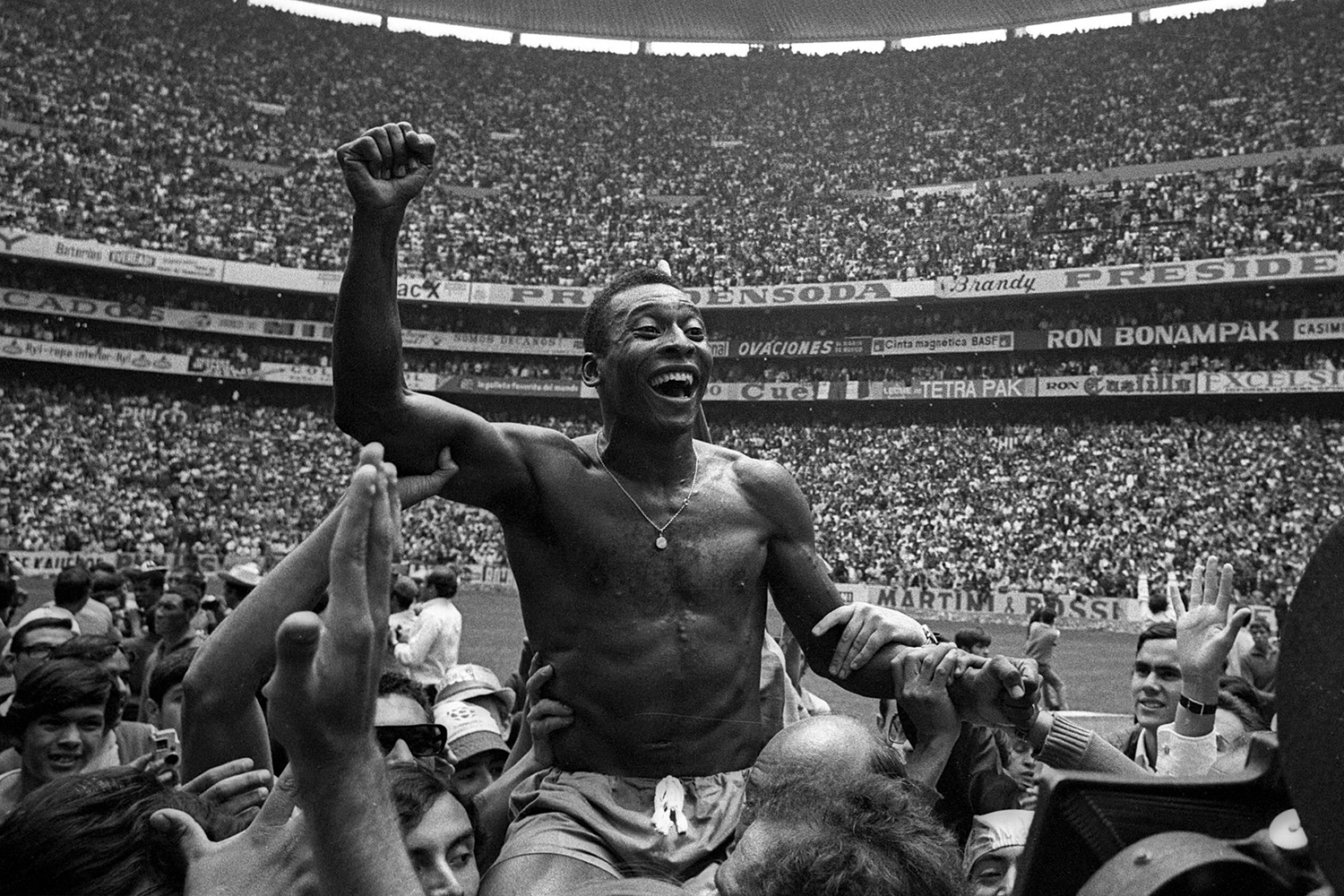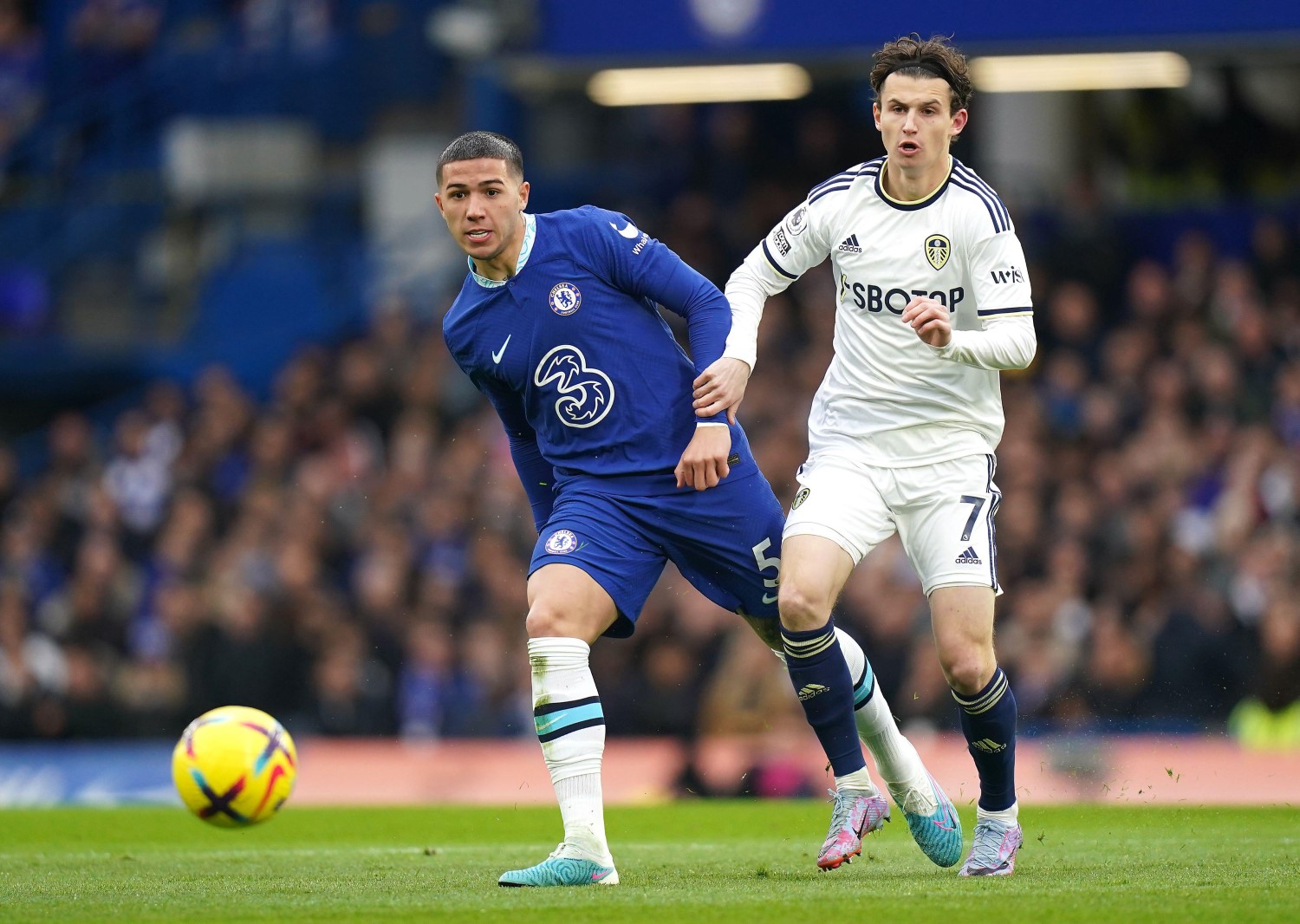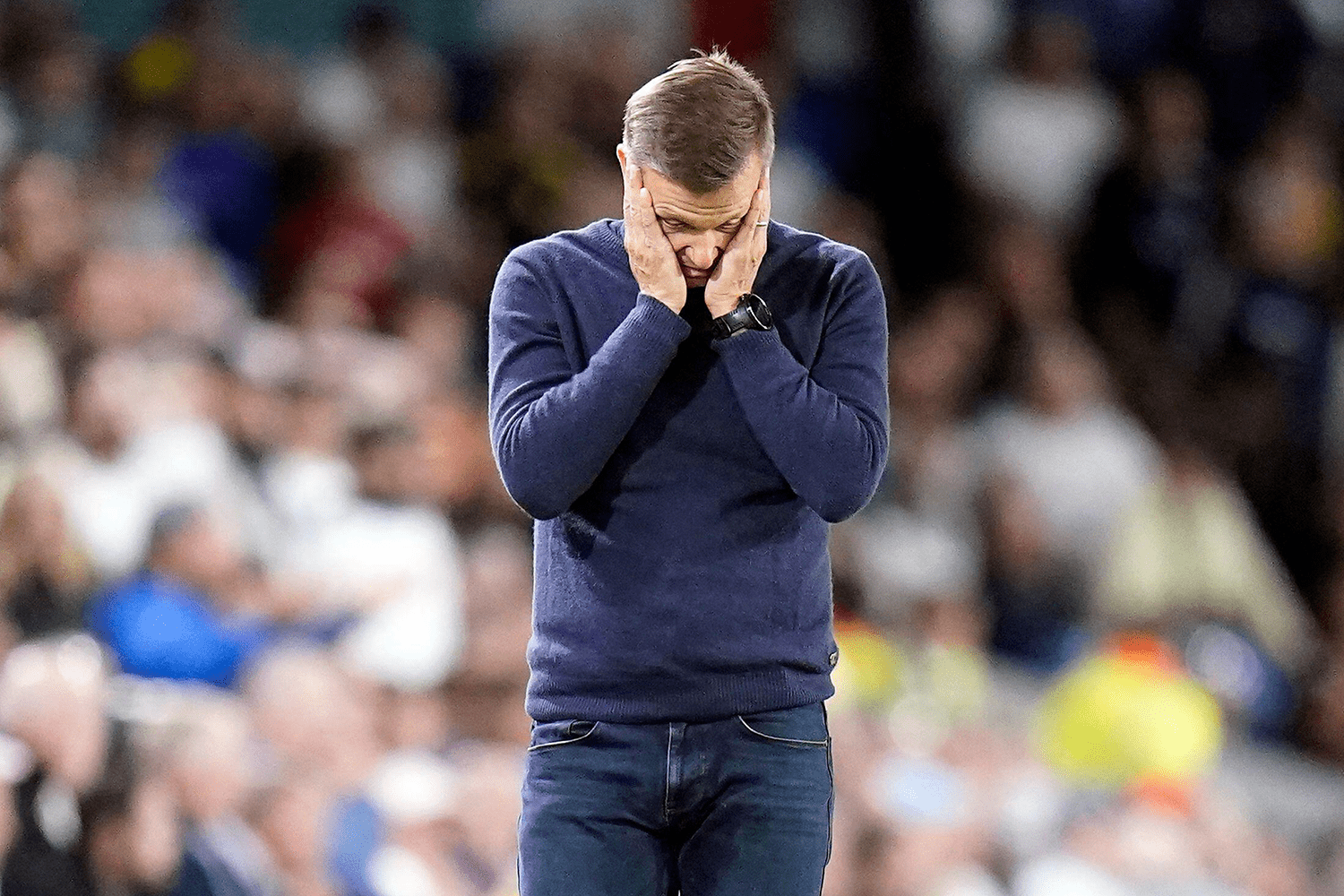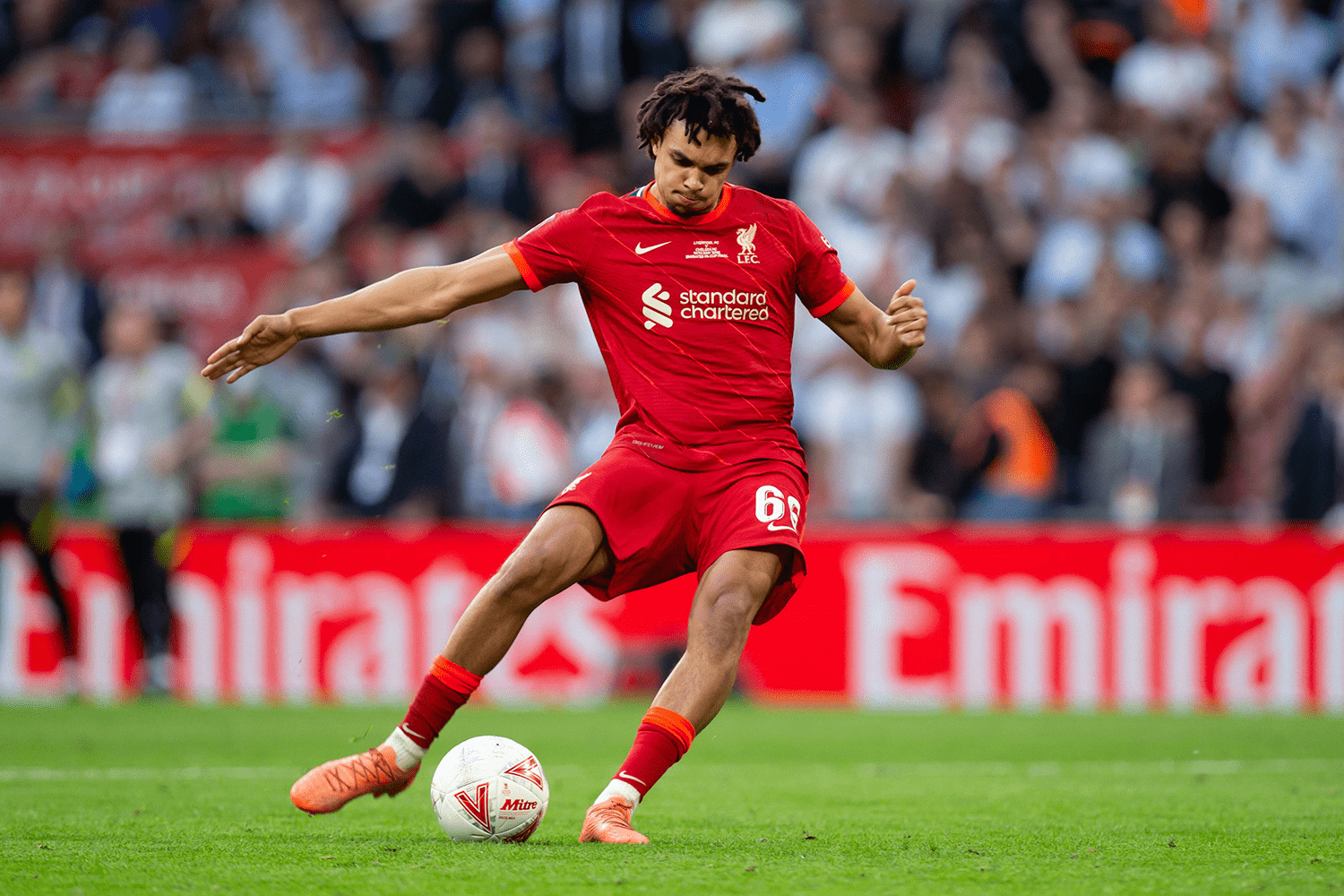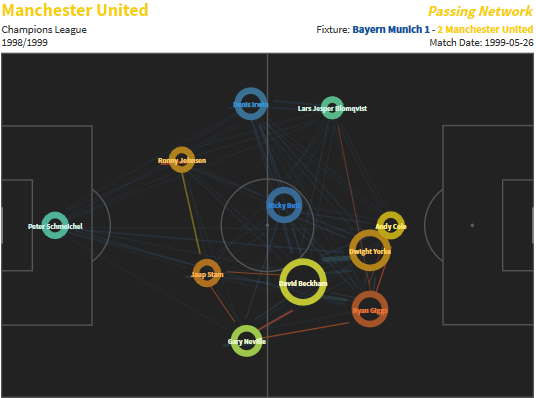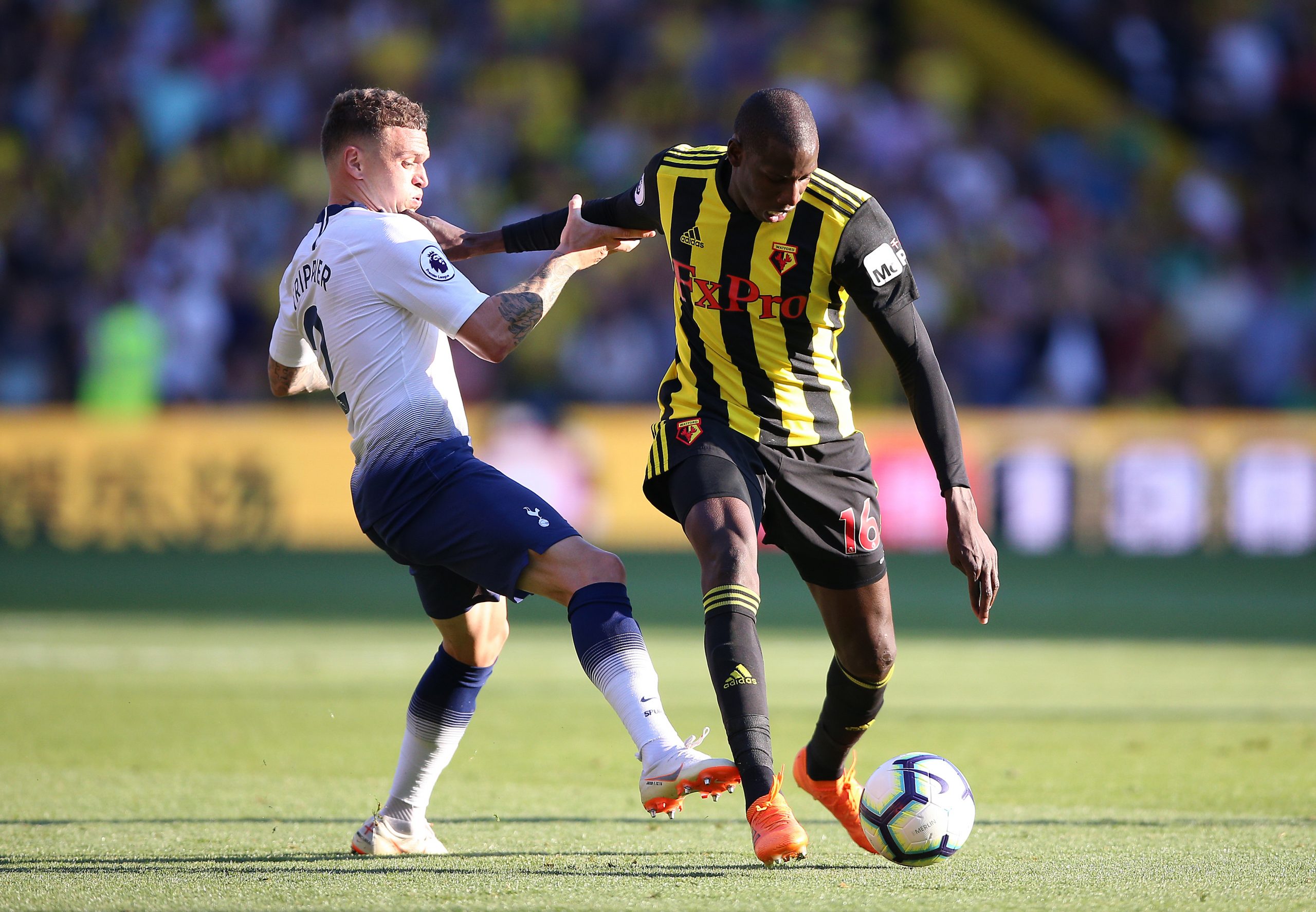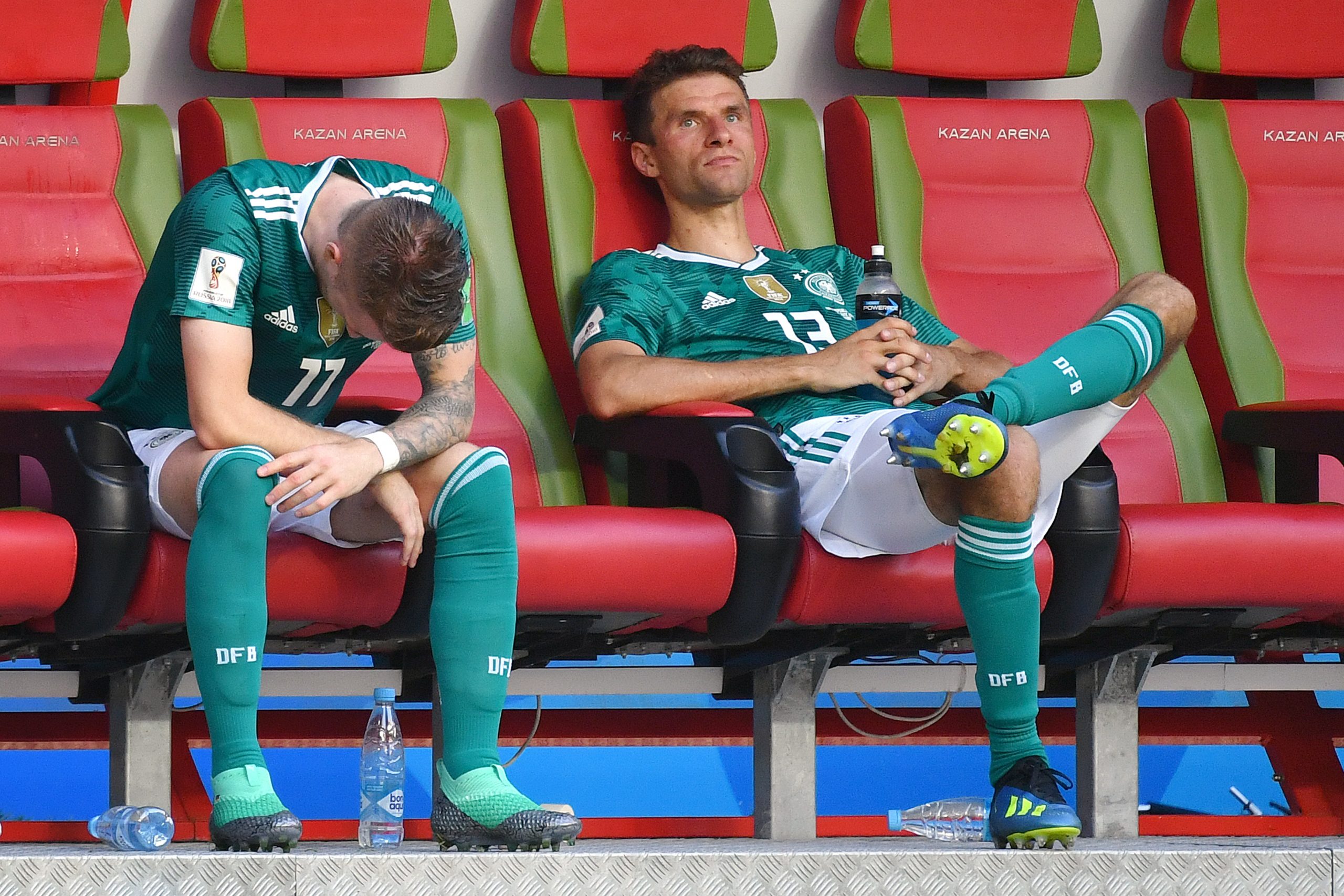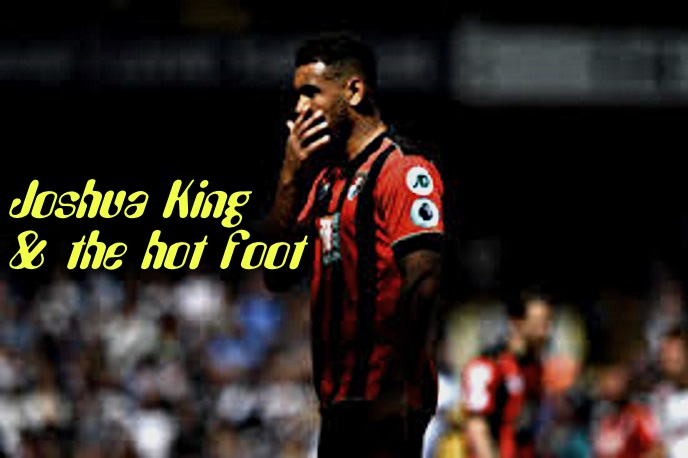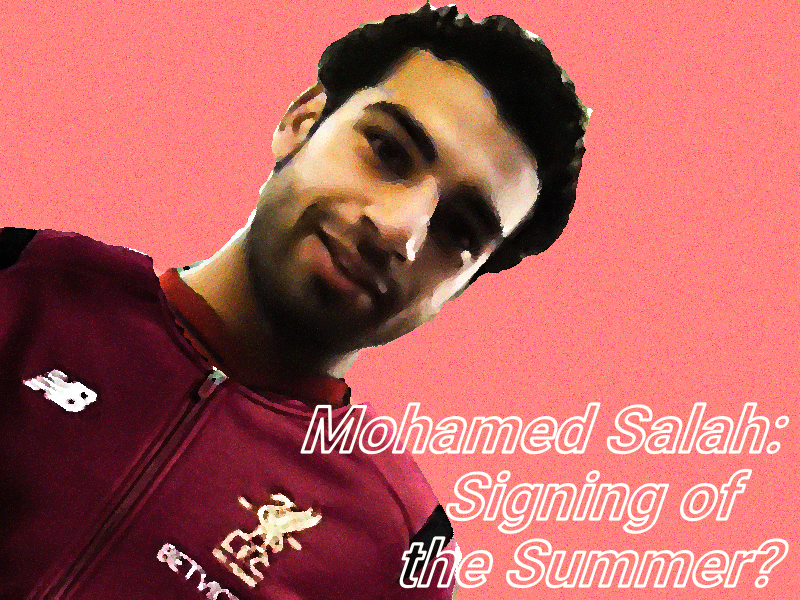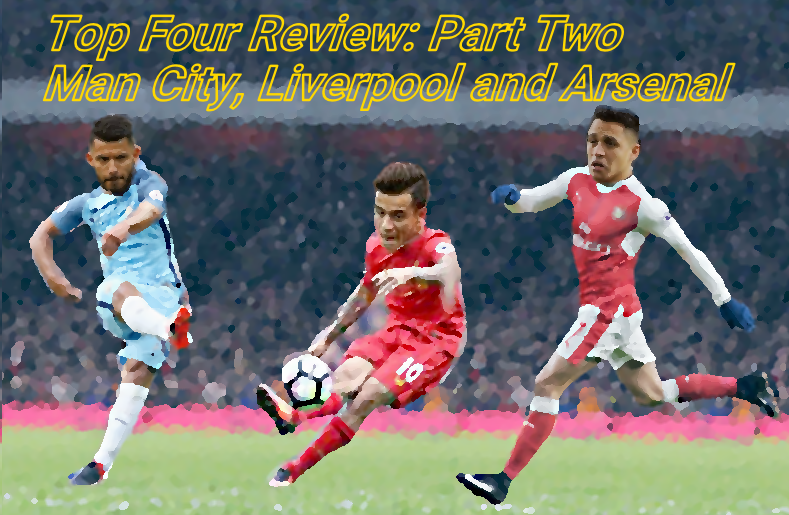Author: James Yorke
Come In Number 5: Line-Breaking Midfielders In The Premier League
Thoughts On Leeds Under Marsch 2022-23
StatsBomb 360: Exploring Line Breaking Passes
Coding Up History: The Man Utd 1999 Project
It's been great to see the results of the 1999 Project come to fruition these last few days.
For those who missed it, StatsBomb teamed up with The Independent to run a series of articles looking at three key games in Manchester United's 1999 treble season through the lens of modern statistics.
Twenty years on, the classic Giggs semi-final against Arsenal, the FA Cup final against Newcastle and the crowning glory, the Champions League against Bayern Munich were all coded up with the current 2019 StatsBomb dataspec and Mark Critchley did a great job reframing the narrative in which stats sit alongside the memories.
The original articles can all be viewed here:
Mark has covered a lot of detail across the games so do give them a read if you missed them, but I thought I'd add in a few broader notes on top. It's scarce that we get to see historical football via any other method that our memory and the narratives that persist. Few people can think that luck didn't play some part in Man Utd turning around a deficit against Bayern in injury time, but one comment we received was that as remembered, Bayern were better overall and United were lucky to even be in the game to stage a comeback.
That was my own general recollection too.
However, when you pick it apart, sure Carsten Jancker hit the bar with a speculative overhead kick, but Bayern essentially weren't better. The shot count was fairly equal overall, but Bayern scarcely got decent chances close in and the pass volumes were 60:40 in United's favour. United did create chances in good locations, and can perhaps be classed as unfortunate not to have drawn level before. It's likely that our collective memory is influenced by the game state: Bayern leading for 83 minutes in a fairly even game to some extent gives the impression of control.
There is also the historical context of how football has changed. The obvious hook here is the formations the teams essentially lined up in. Man Utd started in a 4-4-2 in all three games we coded as did Arsenal in the FA Cup semi-final and Newcastle in the FA Cup final. Bayern played with Jancker in a more solitary role up front and Lothar Matthäus in a sweeper role, so more of a 5-4-1/5-2-3. Is it any wonder central midfielders from this era are revered? How much space was there in the centre of the pitch?
Pressure
Here are the pressure events from the three games:

It's probably easy to think back and presume the FA Cup final was the least intense of these three games since Man Utd won fairly comfortably, but this is the one game in which pressure events veered away from the midfield, at least for United. For Newcastle, Gary Speed put in a heck of a shift as did Dietmar Hamann before he was replaced at half time.
Elsewhere, Arsenal saw Emmanuel Petit and Patrick Vieira most active and Nicky Butt, David Beckham and Roy Keane were most active for United. Interestingly, Tony Adams and Jaap Stam score highly in this match (and Ronny Johnsen does also in the Champions League final). Their no nonsense active defending often saw them move up the pitch to engage with attackers, and this is borne out to a degree here. Adams also recorded three fouls up near the half way line.
This style of defending on the front foot, stepping out of the back line to engage the opponent, is something that appears less common twenty years on, and nowadays when we evaluate pressure events, centre backs often rank low. Lastly, in the Champions League final, midfielders came to the fore again with Jens Jeremies and Stefan Effenberg patrolling midfield for Bayern, while Jancker did plenty of work up front, United, with significant possession, were less active off the ball.
Their strikers were particularly inactive: see the totals of Dwight Yorke (6) and Andy Cole (5). This is a contrast to just days before and the FA Cup final which saw Teddy Sheringham (35) and Ole Gunnar Solskjaer (34) racking up the effort. Game state, tactics and respect for the quality of the opposition could all play a part here but such a difference in style and personnel is notable.
Quarterback Beckham
It's quite fun to see peak era David Beckham filling in in central midfield in the Champions League final. As his career moved on he played there more frequently, but earlier on, the very reasonable idea that he wasn't defensively robust enough meant he wasn't deemed an ideal fit there. Add in how effective he was as a peerless crosser of the ball and he was most often deployed as a traditional right sided midfielder (he was never really a winger per se). Here's his pass map from that Champions League final, as the right side of a CM two:
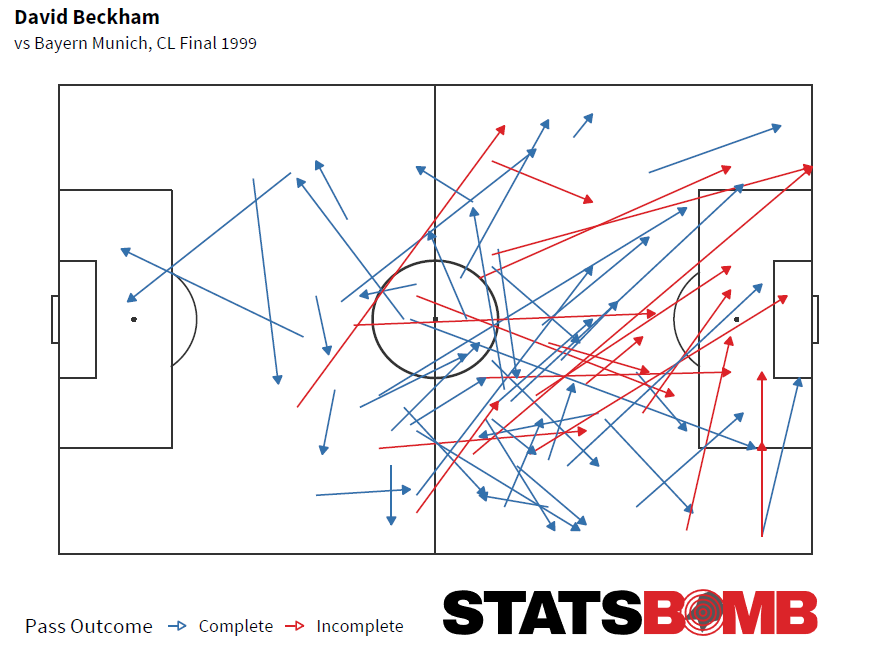
So many long passes! 38/40 ground and low passes, and 6/22 high passes but a real lack of the shorter passes you might expect from a central midfielder. Contrast that with Nicky Butt, a player who very much eschewed the extravagant throughout his career:
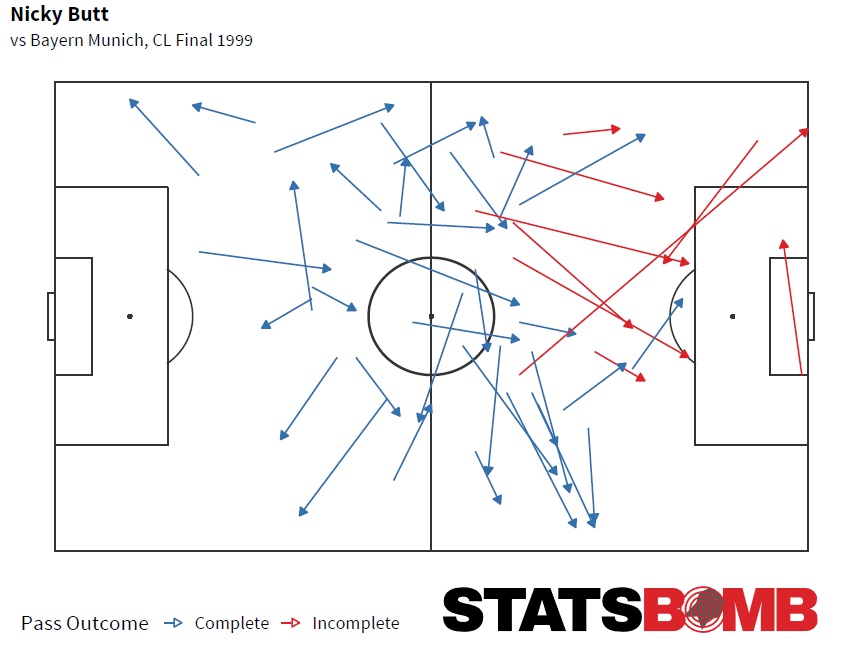
Kept it simple! I'm enamoured with the idea that in the most important game of his career, Beckham got the chance to fill in as a central midfielder and proceeded to attempt his full range of passing.
Was this the basis of him thinking later that this was his ideal position?
Was this the birth of "Quarterback Beckham"?
I don't recall, but much like Wayne Rooney's latter day England career, in which he appeared to feel he was more of a central creative hub than the forward he had been before, Beckham's late England career featured many questions about whether he could play in central midfield and was more than just a world class right midfielder with an insane work ethic and top tier delivery. Regardless, in this game it translated as 71% passing from central midfield, quite a lot of turned over ball and essentially a very direct strategy.
Pass completion
This directness also pans out to the bigger picture. In this match as a whole there were 659 open play passes attempted of which around 69% were completed. This was a game between two of the strongest teams in Europe yet neither team impressed with their completion percentage (Man Utd 72%, Bayern 68%). Check out how that shapes up against every single game in the Champions League of 2019:
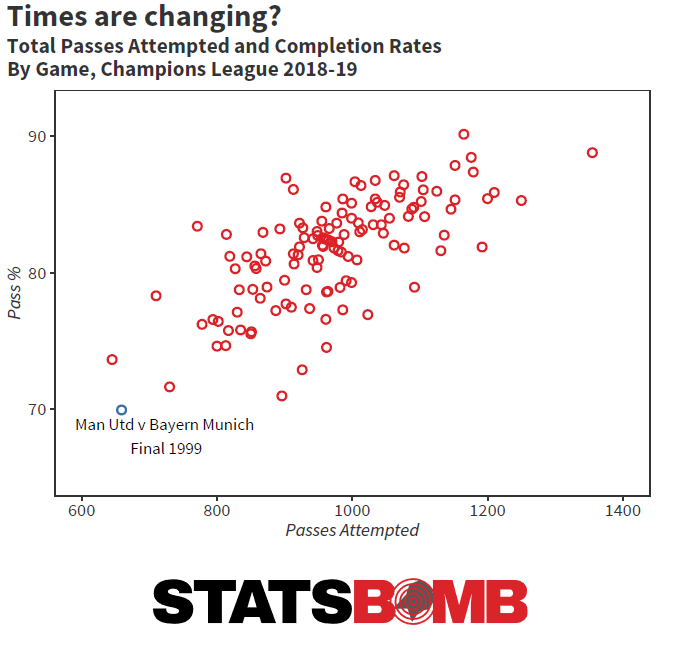
Passes were completed at a higher rate in every single Champions League game this season and only Porto v Galatasaray featured fewer actual passes. Back in 1999, against Arsenal and Newcastle, the pass volumes were much higher, but the pass completion rates were still low (Arsenal 73% v Man Utd 72%, Newcastle 72% v Man Utd 64%).
It's worth considering that the Spanish teams of the late '00s, the influence of Pep Guardiola and stylistic hooks to value possession, slow down attacks and be less direct, are all in the distant future here. By coding up a handful of historical games, we don't necessarily create irrefutable proof but we do get a window into the past and more evidence to consider fun questions like: Would teams of yore match or exceed modern teams? It's most likely a different game...
____________________________________________________________________
Look out for more historical projects in the future.
Tottenham's Defensive Issues: Fixing the Right Side
After a 3-0 victory at Old Trafford last Monday night, it would be easy to presume that Mauricio Pochettino would be overjoyed. In the moment, he made all the right noises but by the time Friday had come round and he was doing the pre-match press conference ahead of this weekend's Watford game, his mood had soured: "I was so disappointed. I think we need to improve our performance. The first half I wasn't happy and I translated that to the players. We need to fight against the perception. When you compare the perception and the reality, we need to talk about the reality, and the reality was in the first half we can concede one, two or three goals.” This attitude towards the performance is encouraging, for it shows a clear understanding of process, and while the result was ideal, the way in which it transpired was far less so. Across Pochettino’s entire Tottenham tenure, the team has not allowed more than the 23 shots that Man Utd created in this game. In the first instance, that’s a big red flag. Nobody expects a trip to Old Trafford to be a straightforward task, but nor does any plan involve allowing so many shots. Immediately it reflects a lack of control. The obvious kicker here is whether they were good shots. United’s xG for the game came out at around 1.7, so at least in part the answer is “not really”. However, Pochettino was correct in his assessment that United could well have scored, with Lukaku’s jarring miss the most obvious example, and he is correct to be annoyed that his team failed to keep United’s attack quiet. The vagaries of football mean that expectation and reality can often diverge in single matches, or over small samples of games and that’s why analysis is most useful over longer periods. The trend to reset the world and all totals as a season ticks from one to another is understandable but means much early season analysis does not lend itself to hefty evaluation. There really is no need to look at just this season, when we have all of last season that we can happily connect to this and the resulting trends to examine too. And that’s why we end up here: Tottenham’s defensive metrics have been trending negatively since around February: 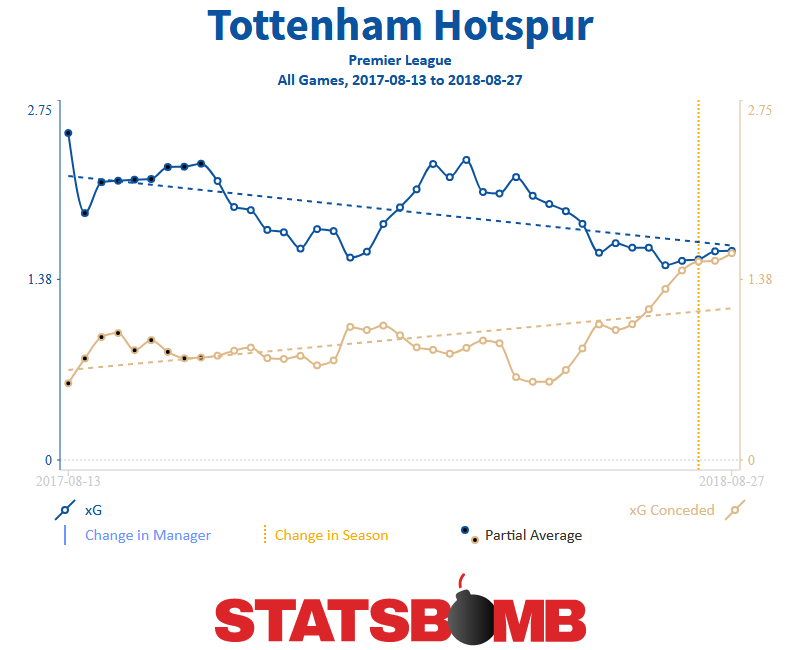 Basically, across the last ten to fifteen fixtures, Tottenham’s expected goal production has been roughly equal in attack and defence. The attack side has been largely good, the defence has not. Let’s define the defensive numbers from the start of 2017-18 onwards, so 42 games. Since 7th April, via expected goals against, we have seen eight of Tottenham’s worst 10 performances:
Basically, across the last ten to fifteen fixtures, Tottenham’s expected goal production has been roughly equal in attack and defence. The attack side has been largely good, the defence has not. Let’s define the defensive numbers from the start of 2017-18 onwards, so 42 games. Since 7th April, via expected goals against, we have seen eight of Tottenham’s worst 10 performances:
| Date | Home | Away | Shots against | xG Against |
|---|---|---|---|---|
| 16 Dec 2017 | Man City | Tottenham | 21 | 3.76 |
| 14 Apr 2018 | Tottenham | Man City | 17 | 2.86 |
| 5 May 2018 | West Bromwich Albion | Tottenham | 14 | 2.28 |
| 9 May 2018 | Tottenham | Newcastle | 18 | 2.00 |
| 7 Apr 2018 | Stoke City | Tottenham | 11 | 1.93 |
| 13 May 2018 | Tottenham | Leicester City | 18 | 1.84 |
| 27 Aug 2018 | Man Utd | Tottenham | 23 | 1.70 |
| 30 Apr 2018 | Tottenham | Watford | 13 | 1.45 |
| 18 Aug 2018 | Tottenham | Fulham | 10 | 1.33 |
| 23 Sep 2017 | West Ham | Tottenham | 12 | 1.30 |
That's eight of their most defensively vulnerable performances across a whole year within their last 11 games--and it's not a case of a bad schedule, there are plenty of games in that list against teams considered weaker within the league. The before and after of expected goal values per shot aren't pretty either with an average of 0.092 before April and 0.105 since. I warned of this general trend in my season preview while remaining positive that Tottenham were well placed to have a successful season. As such it has been disappointing to see the opening games of this season fail to adequately address the problem. It was feasible to estimate that this could have been a late season blip caused by tiredness and/or a drop in focus once trophies had gone elsewhere. After all, it's hard to get a true handle on late season games and in particular the 5-4 season finale win over Leicester feels like it should exist outside any serious analysis, with such a kooky result unlikely to recur.
Defensive changes
Having now come through four games of 2018-19 it feels that Pochettino has an understanding of the flaws in his current team and had been trying to “fix” his team on the fly, with the Watford game, despite defeat, showing the most positive indicators. He will be well aware that performance levels have dropped in recent months and already formation-wise we have seen changes in 2018-19. The three centre back flirtations in early 2017-18 had seemed consigned to history once Toby Alderweireld was first injured then landed in contract purgatory. Now firmly back in the mix, he appears to be first choice alongside Jan Vertonghen but with the option of going with the three once more, and Davinson Sanchez sitting in between and the withdrawal of a midfielder. Against Newcastle, Tottenham started with a back four--and weren't great. Against Fulham they played the back three, were fine until the second half, until Fulham got a real handle on the game in a burst during which they scored, before Sanchez was withdrawn for Mousa Dembélé and control returned. Against Man Utd, the back four returned and United racked up the shots, while against Watford, we saw the back three again, in which despite scoring twice Watford created very few chances. This chopping and changing appears to be an attempt to manage an issue and having looked at both data and watched every shot Tottenham have allowed since February, the source of this defensive woe looks clear: their right side has been vulnerable. Here is a map of the shot assist/key pass locations that Tottenham have allowed since April: 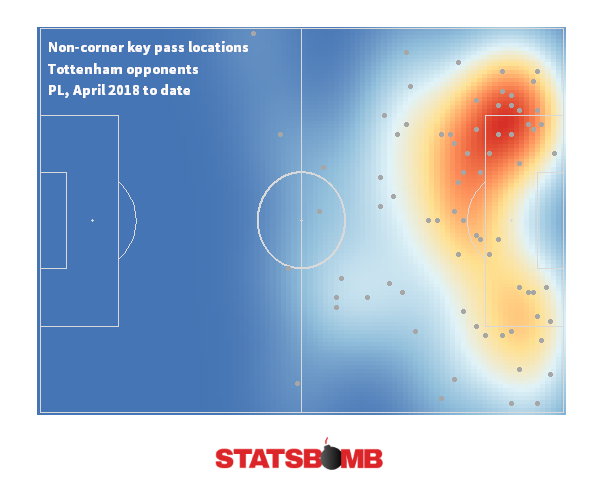
Team issues
It's straightforward to identify a player in a position and earmark them as culpable, and superficially it appears to paint a poor picture for Kieran Trippier. To start with he has started the vast majority of the games in this period with eight, while Serge Aurier has started three games and Kyle Walker-Peters once. Prior to this period Trippier and Aurier shared the role more equally, as is typical of Pochettino full-backs. It's important to back up evidence from data with a wider view and if you actually watch the footage of shots against Tottenham, you see a large volume of attempts are generated from play down his flank, often with him upfield. He is forced to retrieve positions frequently, and even when more usefully positioned, he appears slightly slow to react to attackers' movements, and allows a high volume of passes infield. Ironically, given his reputation for extreme rashness, in general, Aurier appears far more positionally comfortable and feels more joined to his defensive unit. Of course, this analysis can falter if we do not consider other factors: Trippier's role in the team has developed into far more of an attacking contributor and is entirely shaped by instructions: going forward he is extremely good. And we aren't necessarily considering other players charged with patrolling this area--Sanchez or Eric Dier may find themselves required to cover Trippier or Aurier from centre back and defensive midfield positions. It's a fluid issue. There is also a data point here that reflects the defence more generally. Since the start of April, only Arsenal have allowed more shots (74 to Tottenham's 67) within ten seconds of the opposition gaining possession (a measure that also captures most set-pieces). Part of this is a function of how high up the pitch so much of their play is, but also that they have struggled to resist chances via the subsequent opposition attacks. All this is why Pochettino's early season tinkering appears informative. Tottenham's defence isn't performing as well as it has in the past. Getting the three centre back system working does take some defensive responsibility away from Trippier and shunts Alderweireld over towards that location a little more. It looked flawed against Fulham, because eventually a balance in midfield was lacking. Returning to a back four against United and struggling to limit them, Trippier was the first man subbed off, with Aurier replacing him. The pre-match team on Sky were surprised that Pochettino made changes against Watford and Dier's omission was unexpected, but Tottenham--again with three centre backs and Trippier higher up-- put up their best overall defensive performance in literally months, then got sucker punched by two set pieces. That can happen and while the Watford performance was disappointing more from a creative vantage point, it's worth recalling Tottenham created little in either fixture against them last season too. Trippier contributes so much going forward now that is makes sense that Pochettino wants to get him into the team while also minimising any vulnerability that is caused by him being forced to reside deeper and defend. The additional centre back does achieve this.
What next?
It's hard to predict which way this will fall out for Tottenham. The fixture list isn't a clear beacon of hope. They play only eight of their fixtures at "home" during the first half of the season due to the ongoing development of White Hart Lane. By the time they get to seven games will have played just two at Wembley, including a difficult forthcoming fixture against Liverpool. Tough games and away games are not the ideal setting to apply fixes, so the scheduling may well hinder short term progress, while a nearby Champions League visit from Barcelona will surely test any remaining vulnerabilities to the maximum. It feels as though Pochettino is determined to use the stylistic motif and strength of his personnel in persisting towards three centre backs. There are greater issues with choosing who of Alderweireld or Sanchez to omit rather than one of the defensive midfielders right now. However, it might not work in every game, and it will be no surprise if Pochettino defaults back to his normal 4-2-3-1 if or when experiments go awry. Long term, we have also seen his teams consistently overcome late summer and autumnal sluggishness to record stronger and stronger performances as seasons have worn on. Regardless, control is a huge part of Pochettino's outlook, and refinding balance in the team's defence is the most pressing challenge Tottenham face right now.
The Demise Of Germany
By far the most surprising element of the 2018 World Cup has been the inability of Germany to get out of what looked to be a fairly soft group. At least part of that perception is that any group that includes Germany looks hard for the opposition and soft for themselves. Much like Brazil, they are favoured for every tournament they feature in and simply never fail, with semi finals, finals and trophies the norm.
Until now.
How they contrived to fail on the big stage remains a mild puzzle at least part of which can be attributed to the unfortunate ability of three games to fail to accurately represent team quality. Let's take a look at their shot maps:
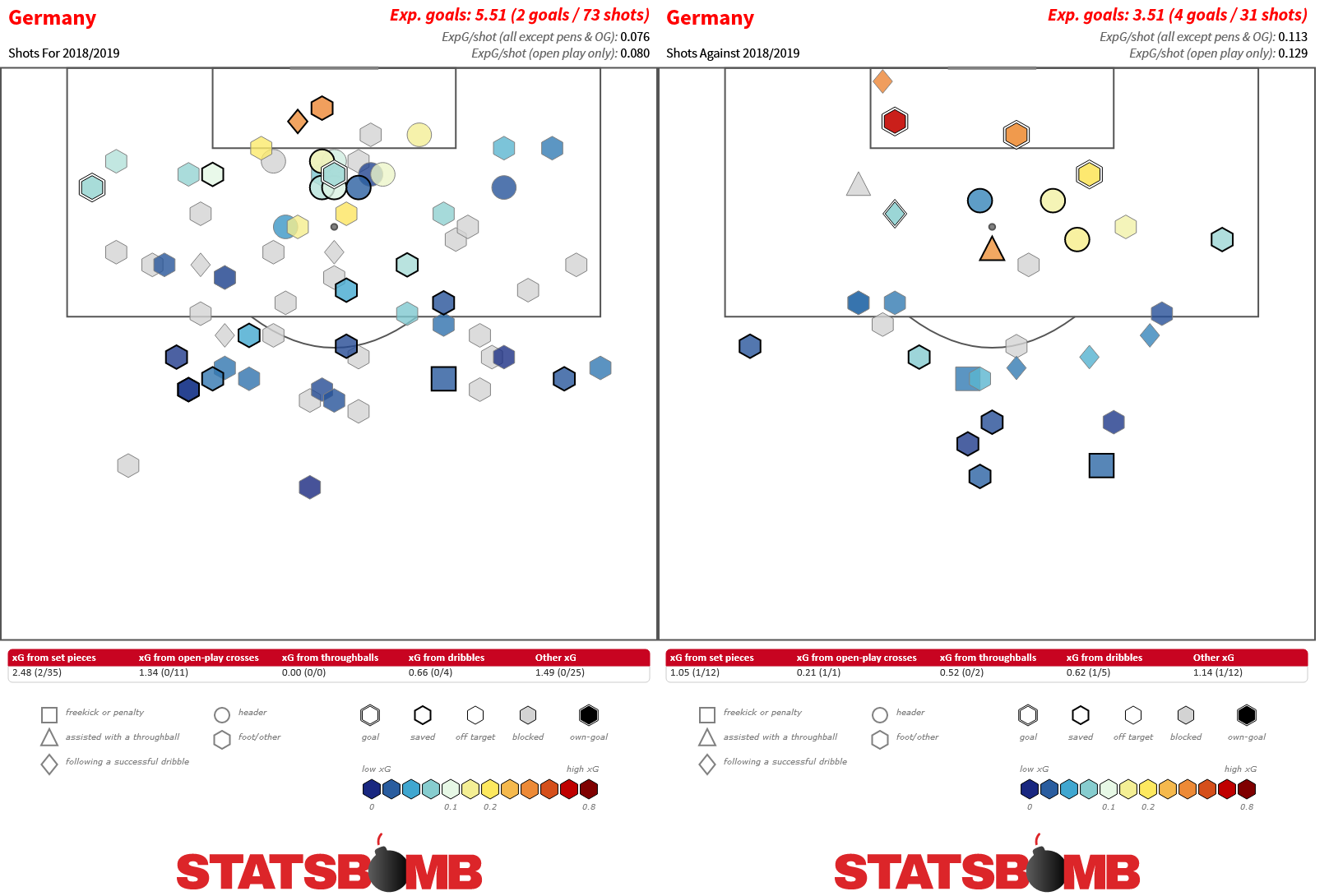
The most obvious thing to note here is an expectation of 5.5 goals compared with a reality of just two. No team took as many shots as Germany in the group stage, but the actual quality of those chances was under par. An xG per shot of 0.08 in open play is distinctly below average (around 0.095) and below what you might expect from a decent side (the better Premier League sides were up towards 0.12 per shot this last season).
The obvious hook here from the South Korea game was the succession of missed chances from what looked like clear headers in the centre of the box. Mario Gomez, Mats Hummels, Leon Goretzka and Thomas Muller all got their heads to the ball in such positions and despite the best of those chances appearing to be gilt edged, they still spec out as relatively low conversion attempts, somewhere in the 0.15 to 0.20 range. The commentator may demand that they "must score" but probabilities disagree.
Given that the single best chance location that Germany carved out in this game involved Hummels wiggling past two defenders in the six yard box, it's hard to be super positive about their chance creation. A pre-tournament gripe, certainly from the Anglo-centric press and fanbase was the lack of Leroy Sané in the squad, and an inability to beat men wide via dribbling was a notable German absence. Mesut Özil, stationed centrally, completed five dribbles against South Korea and had a solid creative game--just without outcome-- but neither of Marco Reus or Leon Goretzka were able to stretch the opposition.
There is also an element of Germany's play that impacted at both ends: speed.
In attack, of Germany's 73 shots, only 16 of them emerged within ten seconds of them gaining possession: that 22% rate is the lowest of the any team in the competition. Germany got plenty of the ball, but they did not attack quickly. Part of this is a function of being a strong passing team trying to break down defensive units, but at no point did it appear that Germany had new ideas towards how to combat their lack of goals. The world waited for them to score, Germany lumbered on, apparently a blunt force and it never came to pass.
In contrast, as was starkly apparent in the Mexico and South Korea games, Germany were vulnerable to quick breaks. They left acres of space in midfield, particularly down their own right side where Joshua Kimmich was often stationed high up the pitch. The 44% of shots allowed that came within ten seconds of a new possession ranks as below average (12th worst) and supports what was only too apparent to a viewer's eyes.
The two South Korean goals skewed any broad numeric analysis of the shots allowed by the German defence, but overall, the goals allowed broadly matched expectation, and in terms of xG conceded, Germany were again firmly mid rank.
Sami Khedira and Thomas Müller had noticeably quiet tournaments but Timo Werner's contribution did not match that one might expect from the number one German striker pick. Compare his shots map from over 260 minutes to Mario Gomez's from around 80 minutes:
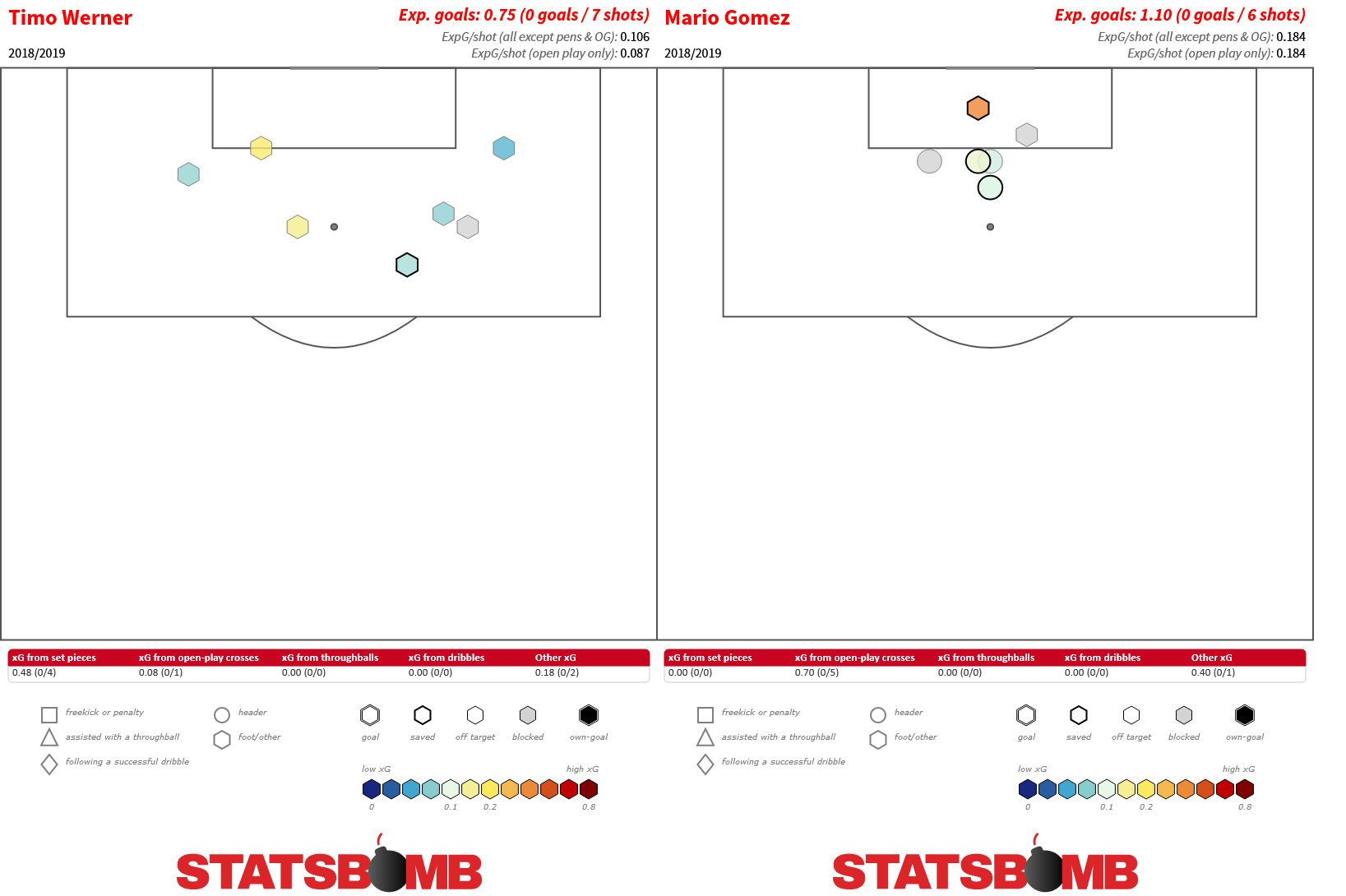
The bottom line remains that neither scored, but Werner clearly suffered in finding the space to get on the end of final balls. It all enters the melting pot of "reasons why" but if your main striker can't score or even get shots off at a rate commensurate to the dominance of the ball that Germany enjoyed, there is likely a link missing in the chain.
Failure has struck Germany square in the face and it feels like a typical lesson regarding squad transition. The core of this team have been together for eight years, and the virility of the 2010 World Cup debut has now given way to sterility as they age together. There has been talk of the German group using advanced machine learning in an attempt to leave no stone unturned, but this failure feels far more like a traditional football error. Revere your champions for too long and your team will not progress or transition. It takes some guts to cast out highly decorated legends, but as the repeated underperformance of recent World Cup winners shows, hard decisions may well be the ones that bear the greatest fruit.
For now, Germany will have to lick their wounds. Their national team structure and support group remains extremely solid and will regroup and rebuild. The message here is that the time to do that is now.
Thanks to Euan Dewar for additional data work here Header image courtesy of the Press Association
Joshua King and the Hot Foot
Joshua King scored sixteen goals in the Premier League last season for Bournemouth. His contributions went a huge way towards securing their 9th placed finish. He has now been linked with a big money move and a fee of around £30m is being suggested.
Playing in various attacking midfield or forward roles, the 2016/17 season was a big step forward for King, after having taken time to find his feet since leaving Manchester United's youth system in 2013. A spell at Blackburn enabled him to play first team football and led to his move to Bournemouth in time for their arrival in the Premier League. Now 25 years old, he will feel he has made his mark, and a move back up the ladder would represent a huge step. But beyond the headline number of the 16 goals, is there anything else we can glean if we analyse his output. Should clubs be taking a chance on him repeating this form, or should they be more circumspect and hold fire? Let's take a look.
Conversion
First thing to note is King took three penalties last season and scored twice. This means for analysis purposes, he scored 14 non-penalty goals. The top line here is that those 14 goals came from 64 shots, the majority of which were with his right foot (44). That represents a conversion rate of over 20% which is on the high side compared to a league average of all shots nearer to 10% and in the knowledge that even prolific strikers rarely land over around 17% on a long term basis; the poacher type such as Miroslav Klose may well get higher. He only took six headed shots from which he did not score, so all his threat came from shots with his feet.
As a starting point for analysis, that high conversion rate looks like a hot goalscoring season that may contain elements that are unlikely to intrinsically recur. But in the first instance, that's just a presumption. Can we identify whether his season was more of an Aaron Ramsey 2013-14 (10 goals from 50 shots, has not repeated) or something more apparently sustainable like Luis Suarez (has converted his shots at a rate of 17% (Liverpool), 21%, 24% and 28% over the last four seasons)?
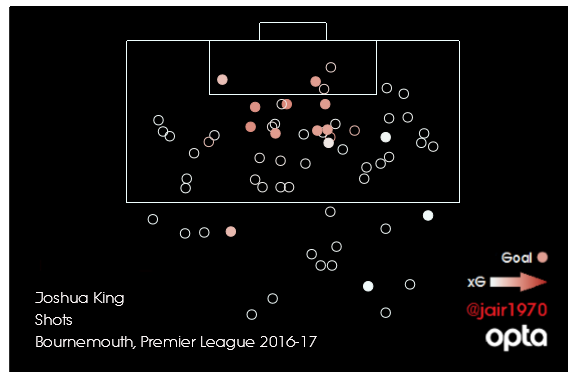
Now goals are only one aspect of King's play, but it's the headline act and the primary reason he is attracting wider interest. The next logical step here is to take a look at his expected goals. The top line is that he scored 14 goals from an expected rate of 8.6. So here we have some confirmation that the insight gained from his goals to shots rate is supported by adding in locational factors (and more). That discrepancy in itself does not offer us insight into how his goals occurred or whether the simple overshooting of expectancy is a product of skill or luck. Plenty of other players overshoot estimations, and do so every season.
During the last four seasons in the Premier League there are 564 instances of a player recording twenty or more non-headed shots in a single season. On a per shot basis, Josh King’s 2016-17 season ranked 14th of 282 that were overperforming goal expectation, so very much at the high end.
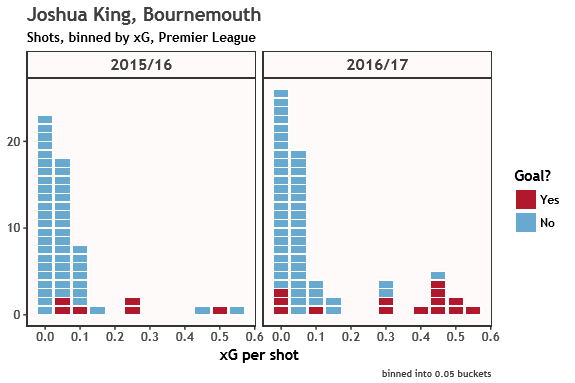
What can we deduce here? Firstly, in 2016-17 he scored three goals from 26 shots with an expected goal value of below 0.05. This can happen, but logically isn’t something that you might presume will continue. When shots with an estimation of one in twenty are going in at a rate of one in eight, it’s far enough out to be notable. Saying that, he was one for 25 in the 0.05 to 0.20 range which means for the entire low probability range he scored four times rather than an expected three. This is well within the realm of normal expectation and considering he went 3/50 in 2015-16 on similar shots, also shows some consistency.
Big and bigger chances
The real action comes from the higher end. Everything from 0.30 upwards here is a designated “big chance” and King holds an apparently impressive record of having scored ten from thirteen attempts (77%). However, this positive return can be tempered by looking at a comparison. Within the Premier League over the last four seasons, there are twenty occurrences of players scoring ten or more non-penalty big chances within a given season. No other player has recorded a conversion rate higher than 71.4%. Conversion rates notoriously fluctuate and King is away and clear at the top end of positive variance.
We can bounce it out to the big five European leagues over the same period, and we find his season ranks 2nd highest of 117 players on a per shot basis (behind only Gareth Bale in 2015-16, who converted 11 of 13 big chances). King may be keeping good company, but the overriding likelihood is that he has enjoyed a hot streak. Over a larger sample, no player finishes above a rate in the his fifties (Alexis Sanchez is on 57.5% on 73 attempts), so when we add in 2015-16, King remains significantly on the high side:
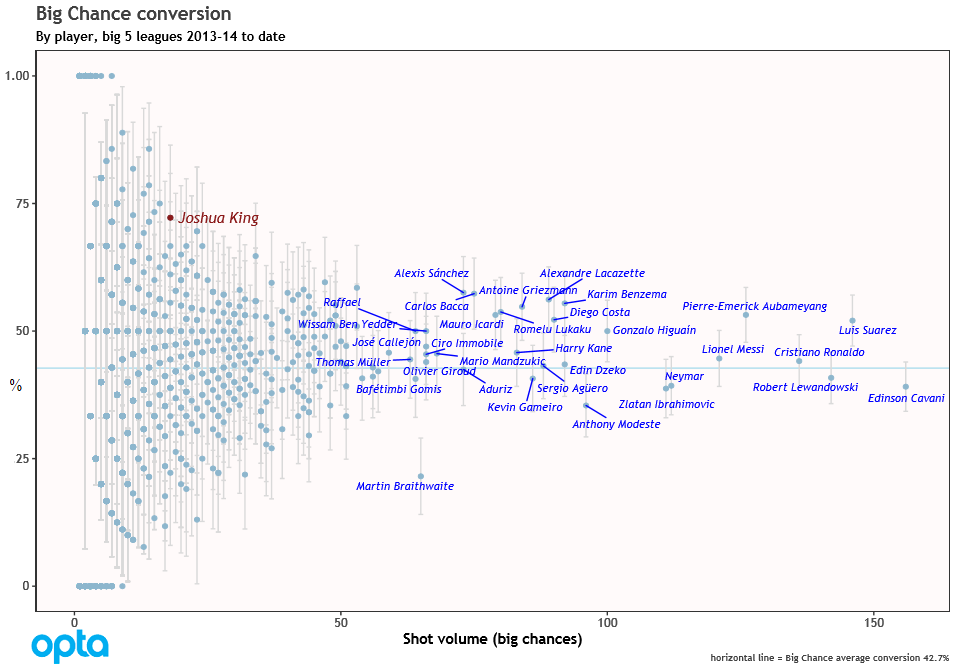
The idea that his goalscoring run is most likely a streak is enhanced when we split the season. Prior to New Year’s Eve, King played 1206 minutes in the league yet acquired just two big chances, both of which he missed. Between New Year’s Eve and the end of the season, he played 1505 minutes and was credited with eleven big chances of which he scored ten, the only miss coming from a left footed shot from a through ball against Middlesbrough. Can King continue to gain high quality chances at this new rate? That’s hard to answer, but over time his ability to finish them will surely reduce.
Positions and other factors
Positionally, the most identifiable change in King’s game came with a consistency of his role becoming central as his scoring run started. Before Christmas he spent time on the right of Bournemouth’s attack, a couple of games on the left and was a substitute on a handful of occasions, as well as time spent at centre forward and a support striker. This move into a pure central role, be it alongside or behind another forward did have an impact on his shooting volume, raising it from 1.5 per 90 minutes played to 2.5, of which as we’ve discussed, a high prevalence of better quality chances enhanced his expected goal rate (latterly 0.4 per 90).
The same before/after split sees an increase in his volume of key passes, from around 0.7 per 90 up to 1.2 after although this flattens to around one per 90 when he is playing centrally apportioned across the whole season. This is a low total, particularly considering his supporting role, and within Bournemouth’s overall 12 shot per game average. He is quite adept with the ball at his feet, and his 2.5 successful dribbles per 90 is on the high side for a central attacking player.
Difficult comparison
This blend of a not very creative running central player is intriguing and uncommonly recreated in the data. Indeed looking for comparative types throws up a variety of decent quality but mainly wide players in their younger seasons, Jordan and Andre Ayew in France, Riyad Mahrez in the Championship. Loosen off the dribbles category and we find 2015 brand Marouane Fellaini (!?). His pass volume of around 20 per game is on the low side for an attacking midfielder and within normal limits for an out and out striker. Should he remain at Bournemouth, and become paired with the notoriously ball-shy Jermain Defoe (whose active ball involvement is fairly similar to Callum Wilson), their attack will remain focused on a midfield that provides for their finishers.
The chief question remains: does 2017 Joshua King profile as a player that could enhance better teams? Is he worth a £30million fee?
Looking at his statistical profile, the goals total from 2016-17 sticks out like a sore thumb in comparison to other factors. There are slight upticks in other areas (shot creation, shots) during 2017, but they don’t appear to diverge significantly from the outputs generated before becoming a core and central player for Bournemouth. Indeed had he replicated the outputs of his 2015-16 season; six goals, two assists, any discussion about his prevailing quality would be moot. On balance, it’s probably correct to presume that 2017-18 will see King continue to be a solid contributor to Bournemouth but not to hit the goal heights of 2016-17. Should this transpire, the idea of £30m bids will wane, and whoever has then become flavour of the month can undergo the same analysis.
Why?
The purpose of this analysis was to give an indication of how much can be done, from nothing more than by simply delving into data. Without recourse to video or sending scouts out, plenty can be learned about the stylistic qualities and trends in a player’s profile. Alongside those analyses, this kind of dissection can and indeed should be performed way in advance of considering bidding for a player. It makes huge sense for clubs to be employing people to do exactly that with a view to enhancing their knowledge ahead of making purchases. Smart clubs will be going much further than this and building player models that mean data for analysis is on tap, visualising player outputs and matching them against their own club’s needs. Multiple leagues can be covered and good practice refined and improved upon.
King represents a relatively simple case for analysis as his goal total has raised his profile, yet is highly likely to be unsustainable. Does that mean signing him would be a mistake? Not necessarily, but it’s imperative that balancing realistic expectation against a large fee and a team’s needs creates a scenario where a club knows what it is getting for its money as far as can be reasonably deduced. With the transfer market inflating and the scope of common sense being employed proving to be hugely variable, the volume of preparatory work put into a transfer should cover all possible eventualities. Errors will never be eliminated entirely, but minimising them should be a primary target. What was a £10million mistake two or three years ago is now likely to cost multiples of that. Football would be well served in spending comparatively small fractions on smart practices to help them. _______________________________________
Mohamed Salah: Signing of the Summer?
It looks like Liverpool are going to make a high end acquisition for their forward line as they close in on the signing of Mohamed Salah. However a little scepticism lies around the deal with Salah having appeared to fail when appearing in the Premier League before at Chelsea and possibly a prejudice against Serie A form translating into the Premier League.
His fee will not be cheap, but when factored against other fees paid this summer, £35 to 40m does not look excessive and his signing will solve a simple problem for Liverpool. With a first choice front three of Philippe Coutinho, Roberto Firmino and Sadio Mané, alternatives have required a different style with Divock Origi and Daniel Sturridge more traditional strikers. Strength in depth is high on Liverpool's priority list and they simply haven’t got a plug and play replacement for their first choice forward three. Salah will offer exactly that with an ability to both score and create.
Performance
In terms of performance, Salah has had two phenomenally successful seasons in Serie A for AS Roma after a promising loan spell in the back half of 2014-15 for Fiorentina. Across that period he has scored 35 league goals and contributed twenty assists. The goals have come at a rate of around one every two games and the assists at a rate of one every three. This is a top class return for a wide forward and scarcely replicated across the top leagues. His expected rate slightly lags (~0.65 expected goals and assists per game, compared to a reality of ~0.8) but is still top class and goals have come from all over, with five from outside the box too. He’s not quite the dribbler his reputation suggests, at least in his time at Roma, and in this he differs to Liverpool’s first choice front three, but potentially that may change in Klopp’s system.
His open play expected assist rate, based on the value of the chances he created as measured by expected goals, lead Serie A in 2016-17 building on a strong 2015-16 total:
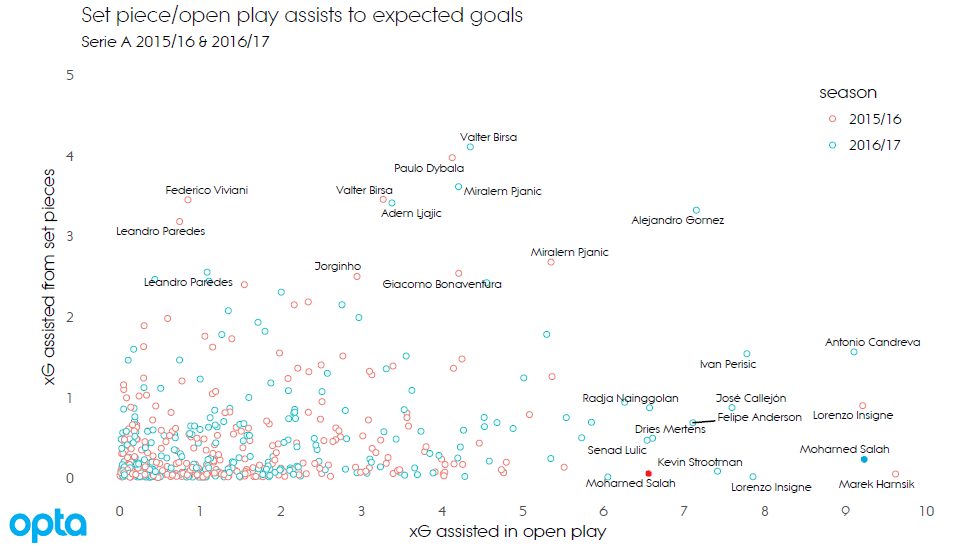
We can see that in 2016-17, he was well capable of creating chances in dangerous areas:
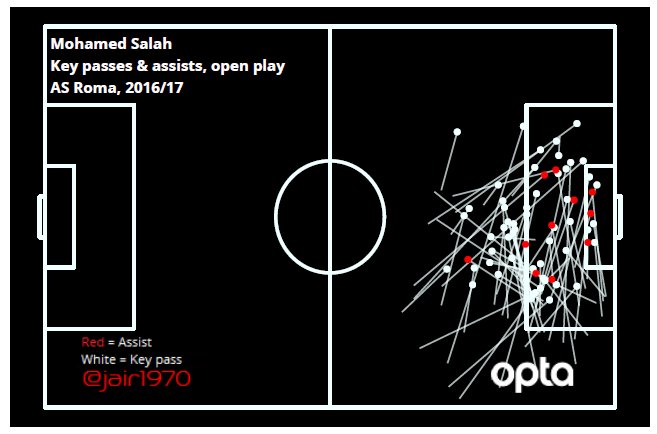
And he managed to find pretty good locations for his own shots too, albeit with a bias to the side he operates on:
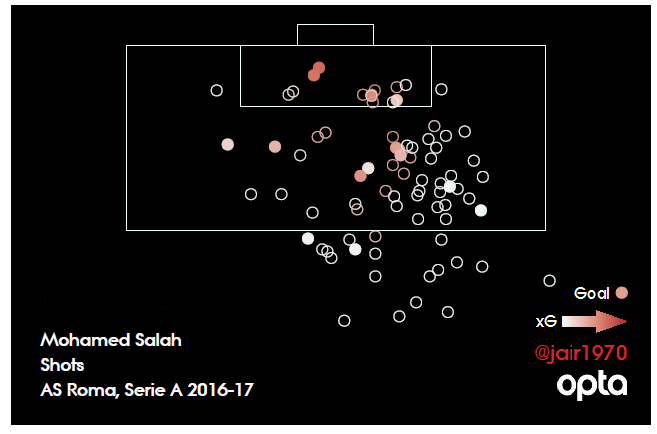
You want a creative goalscorer entering his prime years? Salah ticks all the boxes.
I ran a few checks to look for what he does in comparison to his peers and came up with a short list of players across the last two seasons in Serie A and the Premier League:
- Alexis Sánchez 2015/16
- Alexis Sánchez 2016/17
- Philippe Coutinho 2015/16
- Philippe Coutinho 2016/17
- Lorenzo Insigne 2015/16
- Lorenzo Insigne 2016/17
These er… “deep statistical checks” represent players of Salah’s ilk who have hit and exceeded the same simple benchmarks he has. If you look “up” from Salah, you get these guys. This is good company he's keeping and the combination of creativity and goalscoring ability is again uncommon.
Concerns?
No transfer is a cast-iron certain hit. However, recently Liverpool have done well in identifying types to fit into their attacking corps. Sadio Mané and Roberto Firmino have both proven to be excellent signings and could be forecast to be so ahead of time. We know that Michael Edwards and his team are analytically minded, and both these players were easy to rate highly statistically--like Salah--prior to joining Liverpool.
So what complaints might we have?
“He’s only performed in Italy”
This might seem appealing, but sidesteps the successes in Liverpool’s recruitment. Sadio Mané arrived fresh from a 6th place finish for Southampton, Roberto Firmino came after Hoffenheim had finished eighth in the Bundesliga, Luis Suárez arrived from the Eredvisie and Coutinho was spotted as a kid who was struggling to get gametime at Inter Milan. That Salah has been performing at a high level for the second placed team in Italy is a higher starting point than all these players, which kind of negates the entire argument.
“He failed at Chelsea”
Eh, back in those days, who didn’t? He landed at Chelsea in the January transfer window of Jose Mourinho’s first season back. 2013-14, got around 500 minutes of play, then all but vanished the following year before going on loan to Fiorentina. Chelsea had Eden Hazard and Willian in those seasons, and Mourinho often preferred to play a worker such as Ramires on the opposite flank to his main creative in Hazard while Oscar, though also young was part of that first team unit. Salah’s dynamic attacking style was only ever likely to appear fleetingly at that juncture, and it was unrealistic to expect him to dislodge those senior pros. Kevin De Bruyne and Juan Mata left in the days before his arrival, so it’s not as if routes to the first team were straightforward at all.
The arrival of Cesc Fàbregas in time for the 2014-15 season worked against Salah for two reasons, insofar as Fàbregas now inhabited a position that Salah’s rivals for a starting spot could have occupied. On top of that, the Spaniard’s inclusion meant that once more Mourinho was potentially less likely to empower a pure attacker on the right side of his 4-2-3-1.
Are there any other obvious problems? The African Cup of Nations for one. It won’t come into play til 2019 but now both Liverpool’s prime right sided attackers will be vanishing for weeks on end. And that highlights a secondary issue: really, Salah’s preferred position on the right side is the same role that Mané inhabited all through 2016-17. Each is versatile enough to move into the centre as well, but it might take some tinkering to get right. A plus point is that the purchase of Salah does also offer the tantalising prospect of dropping Coutinho into midfield and running a front three of Firmino, Salah and Mané. The club is spending £35-40m on a player here, and you’d presume that although he will enable rotation of the front three, it would be desirable to get them all on the pitch at times too.
One possible aspect of his play that might not be best served by Liverpool’s striker free model, insofar as he linked up exceptionally well with a resurgent Edin Džeko, particularly last term. Salah created 22 chances for Džeko in 2016-17 of which seven became assists--only Ousmane Dembélé to Pierre-Emerick Aubameyang was more lucrative with ten. However, in 2015-16 Miralem Pjanić to Salah was Roma’s most regular chance creation combination, to show he is capable on either end of the creative process. A strength in intelligence and timing is supported by the fact he made 17 shots from logged through-balls and scored six times across two seasons.
Concerns abated
Salah will arrive at Liverpool with an expectation to be a big part of the first team rotation. This transfer and the stage of his career is very different to his previous visit to England. There are sufficient positive aspects to feel that concerns about this transfer can be generally disregarded.
Liverpool are acquiring prime talent who at 25 years old is likely to spend his best years with them. Salah’s profile appears so solid at this point that nearly any club in Europe could realistically enhance their squad by acquiring him. There is talk that Roma need to sell to balance their financial considerations, and if that’s the case, then Liverpool have stolen a march by stepping in and getting the deal done. I thought Mané was about the most surefire signing of the 2016 summer window and I feel similarly now about Salah. Does this mean he’s a guaranteed hit? No, but once more Liverpool are showing that their process of identifying attacking talent and acquiring it is generally sound. The chance that he succeeds clearly outweighs the risk that he will fail.
__________________
Thanks for reading.
While writing this, I came across this piece by Ray Hamill @finermargins. Well worth taking a look, and had I not already half written my piece, I could've just tapped the retweet button and saved myself a job 🙂 Anyway, check it out.
Top Four Review: Part Two, Man City, Liverpool and Arsenal
[Part one, on Chelsea, Tottenham and Man Utd is here] Man City The Pep Guardiola revolution has had a decidedly flat first season. With prior expectations high, anything short of a title was going to be deemed under par and while third place may seem solid enough in a competitive year, City’s results appeared best before Guardiola’s systems had really taken hold. They started fast before hitting something of a wall and meandering through much of the centre of the season, a superficial storyline that mimicked the year before. Kevin de Bruyne hitting the bar from yards out against Chelsea was held up as a key point in both team’s seasons and it pointed clearly the general trajectory each team then took. A mixed bag of signings generally failed to displace the City mainstays; İlkay Gündoğan was injured, briefly fit then injured again, Nolito fitfully sparkled then disappeared, John Stones looked every inch the potential liability he always has done while Gabriel Jesus was promising and Leroy Sane eventually got motoring to good effect. Wonderment at Guardiola fielding centre midfielders as inverted wing backs or more than two full backs while playing a system featuring no orthodox fullback positions now seems like a quaint reflection of more innocent times. The early fascination with every detail of his selection gave way to accepting that he was going to channel Ossie Ardiles with forward heavy line ups and tinker with his extravagantly assembled squad, come what may. Results stayed erratic until very late on, when they motored home. . Generally, they were too easy to score against, but allowed very few shots. No team allowed the shots that it conceded to land on target as easily as City and no team conceded those shots at such a high rate. That all this did not equate with generally solid locations lightly implied that when shooting the opposition were often unpressured, and the miserable mid-season run of Bravo brings exactly that to mind. They outshot every team they played bar one, Tottenham away, their pass completion was higher against every team they played, and they had more of the ball in every match too. Peponomics was installed and much like Arsenal last year, expected goals loved them, but they struggled to turn such dominance into title contending form. Aspects of variance hindered them at key moments but they can analyse the season and see that much of what they did was very good. However, a flawed squad, underbuilt across multiple seasons, had its weaknesses brutally exposed much as it had in previous years, when perhaps Nicolás Otamendi and a less lean and lumbering Yaya Toure bore the brunt of responsibility. Instead now, Stones and Bravo carried the can. The team had real verve in attack, with the January arrival of Jesus looking to lift it up a gear, but his injury and a slightly flat, though still prolific season from Sergio Agüero meant the team only rarely hit top speed. He scored plenty across all competitions but before a late flurry, only at par in the Premier League, which when held up against the returns of Harry Kane or Diego Costa, who both scored plenty ahead of expectation and when it mattered, reflect exactly what’s needed to power a team late into the season. A goalscorer needs to be on fire, something that Agüero is well capable of achieving, and will need to again. Maybe that's harsh and the real problem was elsewhere with Jesus and Raheem Sterling, with seven league goals apiece, meaning that there was no real backup in goal volume from one player. The continued overlooking of Kelechi Iheanacho was perplexing in this regard. He will represent a solid gamble for someone else should he remain as unwanted as appeared in the latter half of the year. So for Pepalytics season one, what to think? The Champions League demise against Monaco was incredibly tame and he seemed to hint that he felt his players performed within themselves. It still feels like the team needs control and strength in the centre of midfield--Yaya can't be expected to do that forever--while all the full backs have seen better days. Any system will work best when built around Lionel Messi, Xavi, Andres Iniesta all at their peak. Or when installed on top of the wealthiest club in Germany with gamechangers like Arjen Robben, Thomas Muller, Robert Lewandowski or Franck Ribery in the ranks. Who are Man City’s gamechangers? Can they make enough of a difference to lift Pep's values into genuine contention? Reinforcements will be fascinating and inevitable. Full backs at least, surely, three years late, will be incoming. Liverpool Step back from the rollercoaster and what Liverpool achieved last season was against the odds and successful. Sure, this is a club that measures success in trophies and the fantastic early season form led the league title talk to emerge but the bigger picture is that in edging out Arsenal and forcing Man Utd to win a trophy to qualify for the Champions League, Jurgen Klopp’s men have taken a large and well deserved step forward. Pre season, eighth to fourth would have been a fair benchmark for progress, and some of their thrilling attacking play will be remembered and potentially offers a platform for sustained success. That the team was capable of a step forward was well flagged by last season’s metrics, and moreso those confined to the Klopp era. They may have finished eighth but profiled more like a team a coinflip away from the top four, and the deficit wasn’t large. That they had to improve to actually land such a slot indicates the strength of the bigger teams in general. A lot has been made of the variation in results for Liverpool--extremely strong against rivals, but vulnerable against weaker teams. I’m more inclined to suspect that this is a freakish artefact but that Liverpool’s opposition expected goals per shot rate was extremely poor is undeniable. A vulnerability to the second ball on set pieces and an occasionally porous midfield meant that although they allowed few chances, the ones they did were high quality, a problem they shared with Man City. Beyond this, the true problem with Liverpool’s season stems back to May 2016 and their Europa League final defeat to Sevilla. That defeat was a huge fork in the road; a win would have ensured Champions League football, but more importantly a European campaign. The club would not have been able to prepare its squad as it did had it faced European football. Liverpool’s squad depth after the summer of 2016 was simply insufficient, and they failed to remedy that in January 2017. When all were fit, play was scintillating, but as soon as Philippe Coutinho suffered his injury and Sadio Mane departed for AFCON duty, the combination of a fixture pileup and squad weakness quickly told. Liverpool right now perhaps have 14 or 15 definitive first teamers before a steep drop in quality, and then the kids, who Klopp seems reluctant to trust. In truth they probably needed 17 or 18 to get through this season and maintain a high standard throughout, and may need more like 19 or 20 to get through a season with a Champions League campaign glued on. You can’t plan for injuries, but you know they will probably occur, and reliable backups are imperative. Also over multiple seasons, bouncing in and out of European competition plays havoc with sensible recruitment. Tottenham may have fumbled their Champions League run this last season and been lightly mocked for living in the Europa League before, but being involved in European competition year in, year out means that their squad has the depth to combat the fatigue effects that inevitably come with extra fixtures and travel. Liverpool now have to build up again and land straight in the deep end, just as they did after 2013-14. This lack of depth, even with no European schedule, can explain the team’s second half of the season decline in quality. Furthermore Jordan Henderson, Adam Lallana and Sadio Mane all missed chunks at the business end through injury while Daniel Sturridge was variously unused and sidelined. There is talk now of Liverpool moving some of their lesser lights on, In fact, given they probably need four or five first team ready talents to add into the squad, the retention of even a utility type such as Lucas or a back up like Alberto Moreno makes just as much sense. Cast them out and you’ve more slots to fill. That said, Liverpool’s transfer business has been solid in recent years. Roberto Firmino, Sadio Mane, Georginio Wijnaldum and Joel Matip all represent smart talent identification and/or no fear of pushing large fees onto players they trust will fit the club and latterly Klopp’s systems. A couple of early transfers this summer would be a solid look here. So: in review, a good year, with the problems of the season now the challenges of the summer. Liverpool were outsiders of the six teams for the top four, and may well be again, with expectation that Arsenal and Man Utd will contend strongly and the added pressure and workload of a European campaign, but they overcame a wobble this time to secure their spot in the elite. Klopp now needs to find a way to keep them there. Arsenal Eight wins in their last ten, sufficient points to comfortably land in your average top four, an FA Cup final coming up, a deep squad, a legendary manager… what’s not to like at Arsenal? Groundhog Day comes but once a year, every year at the Emirates and said legendary manager now faces the strongest challenge to his autocracy yet after a typically virile end to the season failed to land the usual Champions League qualification. The team found a way to generate more points than last season, but that only tells part of the story. Last year they really should have contrived to build a challenge to Leicester and Tottenham that consisted of more than pipping their North London rivals in the last game. A run of three wins in ten from around halfway killed them off and a similar run of four wins in ten this season, which featured a distinctly vulnerable, and notably bad run in defence, was enough ultimately cost not just a title run but the top four. The biggest disappointment from over here in stats land--and let’s recall Arsenal are well stocked with stats people, so will be well aware of this--is the year on year decline. 2015-16’s side looked like they had benefited from smart advice; the team’s expected goals per shot at both ends was league leading and the volumes were excellent too. They undershot and were better early on, but backed up by Mesut Ozil’s great season, they looked to be the closest team the Premier League had to replicating the shooting efficiency often seen by various Barcelona teams. This year a hot autumn offered a slight sticking plaster to issues that came later and the move from a back four to a back three, which coincided with an upturn in results if not an upturn in underlying performance looked a reaction to the post Christmas slump. Sadly, now we are a long way away from knowing how Arsenal should best line up, and this apparent lack of a cohesive strategy doesn’t get bailed out in the numbers. Year on year, expected goal rates have fallen by a rate only exceeded by Leicester, and when the structure declines, a team is left to rely on variance to succeed, a far less pretty picture than a year ago. Both seasons see a with or without Santi Cazorla narrative easily applied, and even as he approaches his dotage his influence appears key. However, that’s too simple, and Wenger’s strategic transitions appear the biggest driver. Ozil has suffered hugely through lacking a target, and a late season flurry against beach-dwelling opponents hasn’t masked that. Alexis Sanchez has been electric and has benefited from changes more than most, his individual season tallies would have created a greater appreciation had the team itself managed to compete. It does feel as though perhaps the benefit of Sanchez may have hindered the rest of the attacking corps, but as ever things like that are hard to prove. Their impending term in the Europa League offers a line in the sand but also an opportunity. Arsenal are a competent European side, and their style has regularly been more suited to the open play found in European matches rather than the attrition of the Premier League. Perhaps the team is just flawed? Coasting along in comfort, unchallenged by modern ideas or lost in long term malaise? It’s hard. For curiosity’s sake and beyond any “Wenger Out” takes, a new manager would be welcomed just to see what another set of eyes could do with a fairly capable and balanced squad. The possible retention--or not-- of Ozil and Sanchez will likely dominate the summer, with each looking for mega-money but with few mega years left in front of them and a lot of football in their legs. The possible retention--or not--of Arsene Wenger will determine likely whether next season will feel any different. ______________________ Catch me on twitter here, it's a lot of fun: @jair1970
Top Four Review: Part One, Chelsea, Tottenham and Man Utd
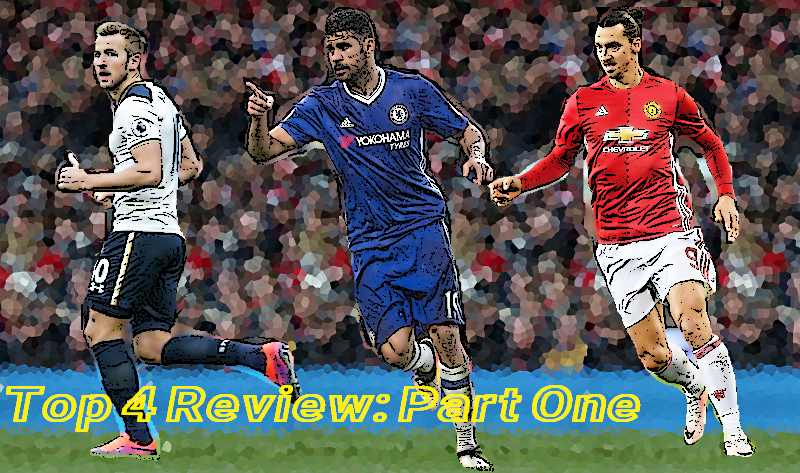 Back in August I kicked off the StatsBomb preview series with an article describing how “six into four won’t go” which looked at the big six clubs and their expectations for the coming season. Each team harboured significant hope of title challenges and comfort within the top four, a desire that could only ever be sated by four of them. We’re now into the last week so this is where we will start to review what happened. I suggested that only Mauricio Pochettino and Jurgen Klopp could realistically land their teams outside the top four and expect to survive, yet Tottenham are safe in second and Liverpool have a home game against Middlesbrough between them and Champions League qualification. I had thought lifting Chelsea from mediocrity back to the summit was a huge task for Antonio Conte (ever shrewd bookies reps had tipped them for the title in seven of thirteen predictions…) I thought Pep Guardiola was nailed on to lift Man City into the top two, while who could foretell Arsenal landing outside their eternal top four positions? Not me. What fascinates beyond the undeniable facts presented by the league table are the changing structure of the competing teams, and how they have evolved season to season. That’s what will inform predictions next time round (with a healthy skew from transfers) as we go again in 2017-18 with the same deal on the table. Six into four won’t go, even if Jose Mourinho can snout out a fifth slot for his team and pretend he wasn’t really playing all along, and next season will find them all on a level playing field with European fixtures for all. This just might open a small window for a well organised interloper to take a run at the orthodoxy, we shall see. Anyway, what do we know, right now? Chelsea, Tottenham and Man Utd’s destiny is decided, so let’s start with them and part two on the other three teams will land further down the line. Chelsea It’s easy to understand how Chelsea were able to shake off the shackles of their dismal 2015-16 and reclaim their title. No European football was huge, team stability and a lack of injuries helped too, as did the talent in the squad, but none of that should take away from Antonio Conte’s achievement to create the basis not just win the title but pretty much crush the league. Autumn’s win streak was the decisive factor, but to win 28 games (and potentially 30) is a devastating return, particularly in a league with such depth in contending positions. He built a dominant team in Turin and has done the same quickly in London with defense the bedrock. If we get into the stats, we find evidence that Chelsea are one of the best teams in the league but not the decisive aspects that are borne out by the table. Expected goals loves Man City, and puts the rest of the big six--Arsenal apart-- into a fairly narrow band. Specifically for Chelsea, year on year we see small gains in attack but huge gains in defence. The 3-4-3 system got a lot of credit as the decisive change after their back to back defeats against Liverpool and Arsenal, but they were already limiting their opponents shot levels beforehand and by and large did so all season. N’Golo Kante got the wide praise, and players bought the hype that a workaholic defensive midfielder can improve a team of expensive world stars and voted him in as Player of the Year; that the writers did the same was somewhat surprising. Why so? “Italian defensive organisation” was the real star here and the roles David Luiz, Gary Cahill, Nemanja Matic, Cesar Azpilicueta, Marcos Alonso and Victor Moses inhabited contributed every bit as much as the diminutive Frenchman, but just lacked the storyline hook that took Kante over the line. This stability allowed Eden Hazard and Diego Costa to once again direct the team’s attack towards another title ably assisted by a sterling second season from Pedro and from his new “special teams” role, Cesc Fabregas. Part of the disconnect between metrics and their success has been their ability to create and maintain positive game states. They have spent nearly half their time in games in winning positions (last season no team spent more than 37% of time ahead) and if we look at a list of similar teams with such a profile they are familiar: Man City 2011-12 and 2013-14, Man Utd 2011-12 and 2012-13, Liverpool 2013-14 and Chelsea 2014-15. All these teams we know as good teams that ran hot with regard finishing in the seasons noted, and won titles or went close because of it. Time (and Leicester) have demystified Man Utd’s 2012-13 title somewhat and what we see here is the perfect recipe for success: quality plus efficiency and luck. This Chelsea team has a slightly different profile to most of these teams given its reputation for defensive strength, yet they’re still the league’s top scorers, powered by some extremely hot finishing rates. Whichever way you turn, Chelsea’s 2016-17 season had all bases covered. They were an excellent team that made the most of their talent and deserved their title. However, next season will be different. They will not win 13 straight games through the autumn with Champions League fixtures intervening, and the potential loss of Costa could be big. In his three seasons at the club he has fired the basis of two titles through hitting rare form in two pre Christmas spells. He’s unique for a top striker as he has rarely hit large shot volumes yet has reliably converted at a high rate across multiple seasons. The money in China will be good, but Conte’s best bet is to spend every penny they get in return at the very top of the market for another striker. Michy Batshuayi will get game time next season and is a solid forward, but Chelsea need to put the very best at the head of their attack if they are to back up this remarkable season. Tottenham In building on a thrilling 2015-16 and securing a clear “best of the rest” slot behind Chelsea, Mauricio Pochettino deserves almost as much praise as Conte. In another season, it might have been enough to land a title, but to take Tottenham past the “AVB line” of 72 points and bringing his young team clearly forward was a fitting finale for their last year at Old White Hart Lane. It wasn’t all plain sailing though. Champions League apathy, too many draws and key injuries overshadowed the autumn. The team looked to be a blunt instrument, bombarding the opposition with shots from all angles but rarely offering the guile to get behind teams and genuinely hurt them. Indeed, title talk was well wide of the mark back them, with a top four slot seeming no more than a coin flip either, and their climb into such positions only occurred as the new year ticked in. Pre Christmas, Dele Alli had not hit the heights of 2015-16 either, Victor Wanyama was getting daggers from more critical circles and even Christian Eriksen’s form was under scrutiny. That each has come through the ensuing few months with their reputation shored up and even enhanced reflects just how positively Tottenham’s second half of the season has gone, Europa League blip apart. In particular, Eriksen, continues to exist somewhat under the radar, despite making the whole team tick, moreso this year in the absence of Erik Lamela, who at least shared some of the delicate creative tasks last year. Tottenham continued to shoot more than the rest of the league of course, and from a variety of wild, not-so-wild and genuinely good positions. They landed more shots on target than any other team too and the sheer volume of their artillery even allowed expected goals models to rate them, eventually. In that regard they look fairly similar to their 2015-16 brand, with a small uptick in defence, which was boosted in reality by Hugo Lloris (and Michel Vorm) securing an extremely high save percentage, a league leading 78% but that’s the kind of outlying skew that is unlikely to hold long term. This was the primary difference between the two seasons in metric land: they got the rub this time. Last season had the makings--shots, lots of them-- but none of the special sauce in the conversions. This year they shaved a couple of shots per game off their defensive end, got the breaks at both ends and happily rode the positive variance all the way up to second place. That’s maybe frustrating, and Pochettino knows it, judging by his reluctant acceptance of praise that has come his way. Beyond that, the project is still moving in the right direction--and still ahead of time, by at least a season. The way that the team seems to have learned how to dispatch lesser teams is encouraging. Frustrating post-Europe results have been in decline, as has the fall away in performance on and around the hour mark that was prevalent before. And the squad has grown together--they really know each other well, and the systems their manager employs. Fears of a mass exodus are unfounded. It looks as though Kyle Walker may leave, but the core of the team will stay on into the wandering year at Wembley. And that’s the biggest challenge. Just as Chelsea surely won’t win 13 straight again, it’s unlikely that Tottenham will win nine in a row or go unbeaten at home all year again. What they need to do is return with the same basic plan: dominate territory, dominate the ball, dominate the shot count, try and rotate effectively, don’t worry about European competition too much and get into the mix. Oh, and not to screw up the transfers. Man Utd What a season! Jose Mourinho nailed the transfers, empowered Zlatan Ibrahimovic and Paul Pogba to run his attack, played it safe in all the games you’d expect him to, tried to shake the remnants of Louis van Gaal from his team’s mentality, built a team that effectively dominated weaker league opposition and for what? A Europa League slot? Ah but notsofast. Win the Europa League and six into five comes into view. Neat twist, Jose. Reality is a stark but familiar comedown but the broad take is simple: despite landing outside the top four Mourinho has done a good job. He’s just been pretty strongly shafted by brother variance and a smidgen of his own caution. From a stats perspective, it’s quite easy to forgive what looks like an underwhelming season. No team has improved its expected rates at both ends by such a combined margin year on year, and it has been split fairly equally between attack and defence. The ten home draws have been frustrating and some of the performance boost can be attributed to the team relentlessly battering on a door that never opened during those games. The bigger picture remains that they are still a work in progress, albeit the most expensive half built team ever known. But, coming into what is a hugely pivotal game against Ajax, one cannot help but reflect on a former prioritisation of Europe in the face of league opportunities, one in which Mourinho failed; Chelsea 2013-14’s season. The die had been cast earlier with odd, meek defeats away at Palace and Villa, and there was no way of predicting that Man City would win out with five straight but Chelsea were bang there until very close to the end of that year. Ever the pragmatist, Mourinho put out a weakened side away at Liverpool staring down a five point deficit and played for the steal. That he got it yet proceeded to get knocked out of the Champions League with his first team intact, meant that overall the strategy failed. He ended up with nothing. We once more reach this juncture with all the chips on the European table and none saved for the league. Two points from twelve are his post Zlatan return, and seven points back from fourth, a preferred league finish is long gone. More concerning is that whether by plan or accident, Man Utd haven’t put together a strong attacking performance since Ibrahimovic went down. In fairness, that run includes both legs of their Europa League semi finals and away trips to Man City, Arsenal and Tottenham, but the starkest game on the chart was the 1-1 draw with Swansea. Very different from the 25 to 30 shot 1-1 draws of earlier in the season, this was played out at a flat 12 shots a-piece. Van Gaal-esque. And so Mourinho’s season could be redeemed publicly with a trophy and one that carries a pass into the Champions League. It’s easy to presume that next year should see further consolidation or with added world stars, improvement. Mourinho has unusually used a large squad in this extended season meaning that although a lot of football has been played across four competitions, the minutes have been fairly well apportioned out. The first two seasons of his Chelsea return were characterised by a lack of rotation and where aspects of burnout definitely impacted the team late on, United may not suffer that way going forward. If Mourinho is to see history repeat, signings of the calibre of Fabregas and Costa are required to push the team forward. That worked for him at Chelsea, and Man Utd will surely spend. With the Pogba signing showing that money and paying the agent can override the lure of Champions League football the aim will be to pull in top rank talent once more. That Romelu Lukaku shares an agent with Pogba has been noted. We have yet to see the best of Henrikh Mkhitaryan too, he could well be primed for a huge season next year if given support. With eight titles, three second place finishes and a third across his completed seasons as a manager, this season represents his worst finish to date, and that is following up his role in Chelsea’s mid table finish last year. Has the aura gone? Losing to Ajax would sharpen the criticism in that direction, but next season will tell us a lot more. He finally got the job he craved, and so far hasn’t quite managed to live up to his or Man Utd’s high standards, yet could end up with two trophies. That would be a successful first year for any other manager in any other club, and there’s enough will, good or otherwise, for Jose to go again. Another year outside the top four will simply not pass muster.
Back in August I kicked off the StatsBomb preview series with an article describing how “six into four won’t go” which looked at the big six clubs and their expectations for the coming season. Each team harboured significant hope of title challenges and comfort within the top four, a desire that could only ever be sated by four of them. We’re now into the last week so this is where we will start to review what happened. I suggested that only Mauricio Pochettino and Jurgen Klopp could realistically land their teams outside the top four and expect to survive, yet Tottenham are safe in second and Liverpool have a home game against Middlesbrough between them and Champions League qualification. I had thought lifting Chelsea from mediocrity back to the summit was a huge task for Antonio Conte (ever shrewd bookies reps had tipped them for the title in seven of thirteen predictions…) I thought Pep Guardiola was nailed on to lift Man City into the top two, while who could foretell Arsenal landing outside their eternal top four positions? Not me. What fascinates beyond the undeniable facts presented by the league table are the changing structure of the competing teams, and how they have evolved season to season. That’s what will inform predictions next time round (with a healthy skew from transfers) as we go again in 2017-18 with the same deal on the table. Six into four won’t go, even if Jose Mourinho can snout out a fifth slot for his team and pretend he wasn’t really playing all along, and next season will find them all on a level playing field with European fixtures for all. This just might open a small window for a well organised interloper to take a run at the orthodoxy, we shall see. Anyway, what do we know, right now? Chelsea, Tottenham and Man Utd’s destiny is decided, so let’s start with them and part two on the other three teams will land further down the line. Chelsea It’s easy to understand how Chelsea were able to shake off the shackles of their dismal 2015-16 and reclaim their title. No European football was huge, team stability and a lack of injuries helped too, as did the talent in the squad, but none of that should take away from Antonio Conte’s achievement to create the basis not just win the title but pretty much crush the league. Autumn’s win streak was the decisive factor, but to win 28 games (and potentially 30) is a devastating return, particularly in a league with such depth in contending positions. He built a dominant team in Turin and has done the same quickly in London with defense the bedrock. If we get into the stats, we find evidence that Chelsea are one of the best teams in the league but not the decisive aspects that are borne out by the table. Expected goals loves Man City, and puts the rest of the big six--Arsenal apart-- into a fairly narrow band. Specifically for Chelsea, year on year we see small gains in attack but huge gains in defence. The 3-4-3 system got a lot of credit as the decisive change after their back to back defeats against Liverpool and Arsenal, but they were already limiting their opponents shot levels beforehand and by and large did so all season. N’Golo Kante got the wide praise, and players bought the hype that a workaholic defensive midfielder can improve a team of expensive world stars and voted him in as Player of the Year; that the writers did the same was somewhat surprising. Why so? “Italian defensive organisation” was the real star here and the roles David Luiz, Gary Cahill, Nemanja Matic, Cesar Azpilicueta, Marcos Alonso and Victor Moses inhabited contributed every bit as much as the diminutive Frenchman, but just lacked the storyline hook that took Kante over the line. This stability allowed Eden Hazard and Diego Costa to once again direct the team’s attack towards another title ably assisted by a sterling second season from Pedro and from his new “special teams” role, Cesc Fabregas. Part of the disconnect between metrics and their success has been their ability to create and maintain positive game states. They have spent nearly half their time in games in winning positions (last season no team spent more than 37% of time ahead) and if we look at a list of similar teams with such a profile they are familiar: Man City 2011-12 and 2013-14, Man Utd 2011-12 and 2012-13, Liverpool 2013-14 and Chelsea 2014-15. All these teams we know as good teams that ran hot with regard finishing in the seasons noted, and won titles or went close because of it. Time (and Leicester) have demystified Man Utd’s 2012-13 title somewhat and what we see here is the perfect recipe for success: quality plus efficiency and luck. This Chelsea team has a slightly different profile to most of these teams given its reputation for defensive strength, yet they’re still the league’s top scorers, powered by some extremely hot finishing rates. Whichever way you turn, Chelsea’s 2016-17 season had all bases covered. They were an excellent team that made the most of their talent and deserved their title. However, next season will be different. They will not win 13 straight games through the autumn with Champions League fixtures intervening, and the potential loss of Costa could be big. In his three seasons at the club he has fired the basis of two titles through hitting rare form in two pre Christmas spells. He’s unique for a top striker as he has rarely hit large shot volumes yet has reliably converted at a high rate across multiple seasons. The money in China will be good, but Conte’s best bet is to spend every penny they get in return at the very top of the market for another striker. Michy Batshuayi will get game time next season and is a solid forward, but Chelsea need to put the very best at the head of their attack if they are to back up this remarkable season. Tottenham In building on a thrilling 2015-16 and securing a clear “best of the rest” slot behind Chelsea, Mauricio Pochettino deserves almost as much praise as Conte. In another season, it might have been enough to land a title, but to take Tottenham past the “AVB line” of 72 points and bringing his young team clearly forward was a fitting finale for their last year at Old White Hart Lane. It wasn’t all plain sailing though. Champions League apathy, too many draws and key injuries overshadowed the autumn. The team looked to be a blunt instrument, bombarding the opposition with shots from all angles but rarely offering the guile to get behind teams and genuinely hurt them. Indeed, title talk was well wide of the mark back them, with a top four slot seeming no more than a coin flip either, and their climb into such positions only occurred as the new year ticked in. Pre Christmas, Dele Alli had not hit the heights of 2015-16 either, Victor Wanyama was getting daggers from more critical circles and even Christian Eriksen’s form was under scrutiny. That each has come through the ensuing few months with their reputation shored up and even enhanced reflects just how positively Tottenham’s second half of the season has gone, Europa League blip apart. In particular, Eriksen, continues to exist somewhat under the radar, despite making the whole team tick, moreso this year in the absence of Erik Lamela, who at least shared some of the delicate creative tasks last year. Tottenham continued to shoot more than the rest of the league of course, and from a variety of wild, not-so-wild and genuinely good positions. They landed more shots on target than any other team too and the sheer volume of their artillery even allowed expected goals models to rate them, eventually. In that regard they look fairly similar to their 2015-16 brand, with a small uptick in defence, which was boosted in reality by Hugo Lloris (and Michel Vorm) securing an extremely high save percentage, a league leading 78% but that’s the kind of outlying skew that is unlikely to hold long term. This was the primary difference between the two seasons in metric land: they got the rub this time. Last season had the makings--shots, lots of them-- but none of the special sauce in the conversions. This year they shaved a couple of shots per game off their defensive end, got the breaks at both ends and happily rode the positive variance all the way up to second place. That’s maybe frustrating, and Pochettino knows it, judging by his reluctant acceptance of praise that has come his way. Beyond that, the project is still moving in the right direction--and still ahead of time, by at least a season. The way that the team seems to have learned how to dispatch lesser teams is encouraging. Frustrating post-Europe results have been in decline, as has the fall away in performance on and around the hour mark that was prevalent before. And the squad has grown together--they really know each other well, and the systems their manager employs. Fears of a mass exodus are unfounded. It looks as though Kyle Walker may leave, but the core of the team will stay on into the wandering year at Wembley. And that’s the biggest challenge. Just as Chelsea surely won’t win 13 straight again, it’s unlikely that Tottenham will win nine in a row or go unbeaten at home all year again. What they need to do is return with the same basic plan: dominate territory, dominate the ball, dominate the shot count, try and rotate effectively, don’t worry about European competition too much and get into the mix. Oh, and not to screw up the transfers. Man Utd What a season! Jose Mourinho nailed the transfers, empowered Zlatan Ibrahimovic and Paul Pogba to run his attack, played it safe in all the games you’d expect him to, tried to shake the remnants of Louis van Gaal from his team’s mentality, built a team that effectively dominated weaker league opposition and for what? A Europa League slot? Ah but notsofast. Win the Europa League and six into five comes into view. Neat twist, Jose. Reality is a stark but familiar comedown but the broad take is simple: despite landing outside the top four Mourinho has done a good job. He’s just been pretty strongly shafted by brother variance and a smidgen of his own caution. From a stats perspective, it’s quite easy to forgive what looks like an underwhelming season. No team has improved its expected rates at both ends by such a combined margin year on year, and it has been split fairly equally between attack and defence. The ten home draws have been frustrating and some of the performance boost can be attributed to the team relentlessly battering on a door that never opened during those games. The bigger picture remains that they are still a work in progress, albeit the most expensive half built team ever known. But, coming into what is a hugely pivotal game against Ajax, one cannot help but reflect on a former prioritisation of Europe in the face of league opportunities, one in which Mourinho failed; Chelsea 2013-14’s season. The die had been cast earlier with odd, meek defeats away at Palace and Villa, and there was no way of predicting that Man City would win out with five straight but Chelsea were bang there until very close to the end of that year. Ever the pragmatist, Mourinho put out a weakened side away at Liverpool staring down a five point deficit and played for the steal. That he got it yet proceeded to get knocked out of the Champions League with his first team intact, meant that overall the strategy failed. He ended up with nothing. We once more reach this juncture with all the chips on the European table and none saved for the league. Two points from twelve are his post Zlatan return, and seven points back from fourth, a preferred league finish is long gone. More concerning is that whether by plan or accident, Man Utd haven’t put together a strong attacking performance since Ibrahimovic went down. In fairness, that run includes both legs of their Europa League semi finals and away trips to Man City, Arsenal and Tottenham, but the starkest game on the chart was the 1-1 draw with Swansea. Very different from the 25 to 30 shot 1-1 draws of earlier in the season, this was played out at a flat 12 shots a-piece. Van Gaal-esque. And so Mourinho’s season could be redeemed publicly with a trophy and one that carries a pass into the Champions League. It’s easy to presume that next year should see further consolidation or with added world stars, improvement. Mourinho has unusually used a large squad in this extended season meaning that although a lot of football has been played across four competitions, the minutes have been fairly well apportioned out. The first two seasons of his Chelsea return were characterised by a lack of rotation and where aspects of burnout definitely impacted the team late on, United may not suffer that way going forward. If Mourinho is to see history repeat, signings of the calibre of Fabregas and Costa are required to push the team forward. That worked for him at Chelsea, and Man Utd will surely spend. With the Pogba signing showing that money and paying the agent can override the lure of Champions League football the aim will be to pull in top rank talent once more. That Romelu Lukaku shares an agent with Pogba has been noted. We have yet to see the best of Henrikh Mkhitaryan too, he could well be primed for a huge season next year if given support. With eight titles, three second place finishes and a third across his completed seasons as a manager, this season represents his worst finish to date, and that is following up his role in Chelsea’s mid table finish last year. Has the aura gone? Losing to Ajax would sharpen the criticism in that direction, but next season will tell us a lot more. He finally got the job he craved, and so far hasn’t quite managed to live up to his or Man Utd’s high standards, yet could end up with two trophies. That would be a successful first year for any other manager in any other club, and there’s enough will, good or otherwise, for Jose to go again. Another year outside the top four will simply not pass muster.
The Worst Transfers Of The 2016-17 Premier League Season
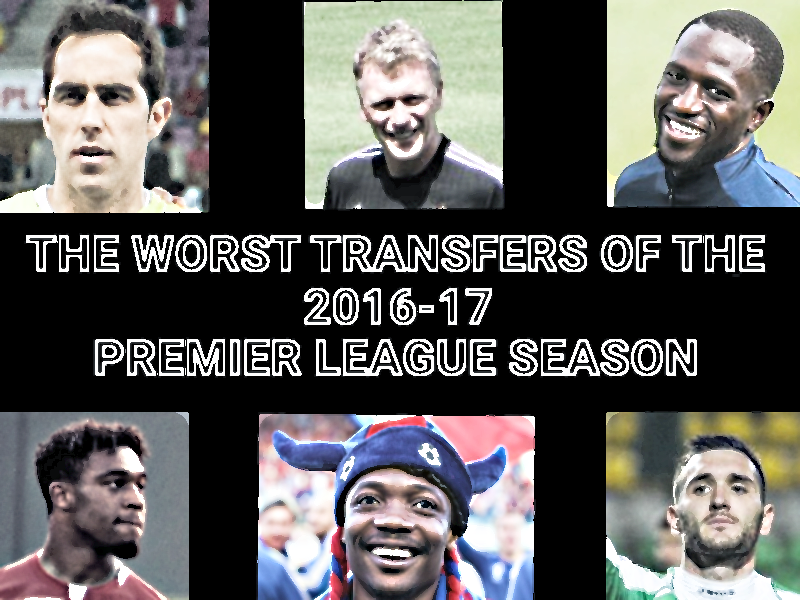 Nobody ever said transfers were easy. The potent blend of vast amounts of television money, an army of agents and an industry that has long been prone to inefficiency has meant that plenty of transfers go wrong. They will go awry for human reasons that are impossible to avoid and they will go wrong even when everything looks like it shouldn't. The Premier League may be slowly starting to think how to make fewer mistakes, but even clubs that appear smart can drop the ball completely and made rash or odd decisions. So here’s a list of deals that didn’t work in the Premier League this last season, for a variety of reasons, but all have one thing in common: they tally up to being a huge waste of money. Often, these deals were easy to criticise from the outset, for others it took time for the lack of sense to become apparent. With fees rising fast and mistakes now costing in the tens of millions, for the most part, it would have been easy enough for you or I to have sat in on the proverbial cheque signing, grabbed the pen and tossed it out of the window. This key role appears to be one that is understaffed in football. Jordon Ibe This is the kind of transfer that lives on the cusp of old football vs new football. Old football watches Jordon Ibe and likes what it sees. He can run, he can beat players, he’s quick, he’s young and he is “promising”. That kind of player is one that many a scout loves, sticks him in the notebook, keeps an eye on him. New football is looking at some numbers and wondering “what gives?” Now it’s tough to come down on a young player but there were red flags here that were visible from a good distance. Firstly, he came through at a huge club in Liverpool, had loan time, spent time in the first team yet at 20 years old they are happy enough to sell him? This is not a Raheem Sterling situation. Looking at his pre-Bournemouth top-flight career, Ibe played nearly 2500 minutes in the Premier League and European competition, scored just two goals and created three assists, from a general shot contribution (shots and key passes) of around three per game. These numbers are very much on the low side for an attacker of any sort, and moreso for one that has gathered up minutes playing for a reasonably high volume shooting side, while getting a good amount of time off the bench. Twenty year old Jordon Ibe did not participate in goals. As a buying club, perhaps you’re okay with this, you think you can find a way of fitting him in, work on these aspects? A cheap bid should do it, right? Couple of million? Alright, five million, times have changed. Au contraire, Bournemouth spent a club record £15million. To spend so much of a budget on a gamble such as Ibe? That is madness. Ibe’s season has not gone to plan. Thirteen league starts all in, but just two since Christmas, including what looks from the outside to be a “prove a point, mate” selection against Liverpool, for which he lasted an hour and created nothing, not even recording one dribble, let alone something useful like a shot. He’s often been sacrificed at half time, or thrown on when the team is getting stuffed, and all the way along 1000-plus minutes, has recorded no goals and no assists. That he has become so peripheral also raises questions about how he is being managed and Eddie Howe could earn some added kudos by finding the key to his record signing. Ibe might still learn, I guess, and his development could move forward, but there is practically no evidence that he will become a Premier League standard player or live up to a big fee. Liverpool already made that call last summer, and for now he is a bust, and one that wasn’t hard to foretell. Claudio Bravo Manchester City could be highlighted in any reflection on last summer’s transfers not least for what they didn’t do rather than what they did. With four aging full-backs in residence, and a slew of senior players on contracts deep into their dotage, obvious problems ahead of Pep Guardiola’s arrival were not solved. They did need centre back cover, and £50m worth of unpolished Stones arrived while the attack was bolstered by Leroy Sané and Gabriel Jesus--expensive young toys aplenty. These deals may well prove very good, but didn't immediately get to the core of City's problems. A broken İlkay Gündoğan for £25m also arrived without a receipt, and Nolito started well before drifting off into the ether but the goalkeeper saga probably represented the worst bit of business of the lot. It isn’t about how good Claudio Bravo has been in his career, or even about how well he has performed in a Manchester City shirt (which hasn’t been good at all: he’s saved 55% of the shots he has faced, the lowest of any keeper in the league this season to play 15 or more games, and sufficiently low to be notable). The crux to why this deal was bad was the price and the age. City’s rear guard is already chock full of over-30s and the old idea that goalkeepers don’t decline like outfielders perhaps doesn’t carry as much weight as it once did. The modern game is ever faster and reactions fade. For every Gianluigi Buffon thriving into his late 30s we find an Iker Casillas type who has hit the wall harder than a Cristiano free kick. Buying a 33 year old goalkeeper is instantly a risk; moreso when you throw £17m at them. City look like they will pay the price for their knee-jerk signing, as another keeper is surely fairly high on their summer wish list. Lucas Pérez Spanish C and B teams, Ukraine, Greece and then a hot couple of years as the main goal getter for a relegation threatened La Liga side are not the general career path for an Arsenal forward. Then again, nor is non-league football, playing with an electronic tag or racial abuse in a casino, but that didn’t stop the early summer bids going in. Already well blessed with attacking talent, it appeared that Arsene Wenger and/or his team had identified a role to buy for; once Jamie Vardy was missed, a Vardy type seemed on the menu. So they turned to Lucas Pérez. Two weeks after signing for Arsenal he turned 28 years old. This was not a signing for the future. Yet what future Perez has at the club already appears in doubt. Having started just two Premier League games and one Champions League game and played around 400 minutes in those competitions, he can hardly be said to have had much of an opportunity to make an impact. When he has featured he’s looked a tidy player--and has seven goals littered around cup appearances and his sporadic league and European outings--but has simply not found favour, even as the team's form careered into the bin. The curiosity is why they signed him, only not to use him? Arsenal have as smart a unit of analysts as any team around. If they signed off on him, he must have shown up exceedingly well somewhere, and one hopes beyond his headline numbers. If Wenger went with his own gut feeling or took other advice, then how could he identify and sign a player who he would then routinely ignore? Perhaps £17m is small change for Arsenal, but regardless, the signing has been almost entirely pointless beyond the enrichment of Pérez and his long term security. That is not to cast an aspersion on him but it will likely be his last (only?) big contract, and a black mark against Arsenal’s generally sound recent recruitment. Moussa Sissoko and Georges-Kévin Nkoudou Vincent Janssen gets a pass here despite a tough year because he’s young, but mainly because it was possible to create an argument that he might have been a good signing prior to his arrival. No such case exists for Moussa Sissoko or Georges-Kévin Nkoudou. It has been tough to break into Tottenham’s first team this season, but on paper, you might expect a £30m French international signing--no, not N’Golo Kante--to knock hard on the door and look to make an impact. Sissoko, has not managed to do this. An ironic season highlight was his shepherding the ball near the corner flag as Tottenham eked out a 1-0 victory over Crystal Palace last week, it represented a rare tangible benefit to his being on the pitch. The main problem with the Sissoko signing isn’t so much that he has failed to have any impact--he hasn’t, having started just ten games in all competitions--it is that it was entirely foreseeable. As the transfer window came to a close last summer, Newcastle fans couldn’t hide their glee that Everton and Tottenham appeared to be battling for their erratic midfielder. Buoyed by an apparently successful Euros (one wonders how he made that squad given France’s depth of talent) and despite having just participated in relegation, he was in demand. But why? During his three and a half years at Newcastle he averaged around two goals and four assists per season and was rarely creative. He had an engine, sure and he could run with the ball, a bit, but nothing about him suggested he had anywhere near enough end product to justify such an elevated fee. Add in that he was 27, significantly older than Tottenham’s generally youthful transfer focus and everything about the deal made no sense. For those who expected little, he has not disappointed. And the fee! Daniel Levy came through for his manager here, but may not again, at least not like this. Having arrived for £9m from Marseille, N’Koudou could not be easily quantified either. He has made just six substitute appearances in the league for a combined 47 minutes. Is he for the future? It seems unlikely. He’s quick but that’s about it. Like Sissoko, nothing in his stats from his time at his former club suggested that he was a player that could fit in or thrive at a top six Premier League club, and sure enough, he hasn’t. Tottenham have made great strides in recent years and often found gems in the transfer market. However, Victor Wanyama apart--a player already known to the manager-- the summer of 2016 was a car crash. If anything changed in the player selection process there, it might be advisable to change it again. Ahmed Musa In recent seasons, Salomón Rondón is about the closest thing the Premier League has to a successful signing out of the Russian League. Otherwise, it hasn’t been a very fertile hunting ground. By now, you might expect that knowledge to have permeated slightly further than it has but Leicester, ever creative in their recruitment, cocked a snook at such an idea and splashed out £17m of their summer budget on Ahmed Musa. He has now made two league starts since Christmas, both 3-0 home defeats (to Man Utd and Chelsea) in which he lasted a half and 71 minutes respectively and beyond that he’s played 41 minutes since February. Neither Claudio Ranieri or Craig Shakespeare appear to have found faith in the Nigerian attacker and he is starting to look very much like an expensive mistake. A percentage call would have been to pass; all transfers involve risk, but it's important to get an idea about league strength when evaluating future signings, in particular ones that clock in at this kind of fee. Islam Slimani narrowly missed the cut here, but his record of actually scoring saved the easy criticism of his club forking out a huge £35m on a striker who turns 29 this June. He has also missed time for injury but Leicester have struggled to nail down their forward line this season, so much so that they have often found well over £50m in transfer fees warming their bench. Strength in depth, or the folly of wealth? Team awards: West Ham Manuel Lanzini’s contract became officially permanent at some point within or after the 2015-16 season. This was a good idea. Subsequent summer transfer dealings were less so. West Ham may have long since waved goodbye to Harry Redknapp, but the tendency to do a bit of transfer business has not left them. Ten players arrived in the summer of 2016, for a variety of fees, some on loan, some permanent. Around £40m was invested on these players, who arrived from such varied locations as Uruguay, Germany, Turkey, Italy, Spain, Switzerland, Greece, England and Wales. One can only presume West Ham have an excellent scouting network to be able to cover the globe so broadly, as the players acquired rarely stood out in the numbers. Indeed Donald Trump would be impressed with such committed deal making. Sadly, this extensive preparation has not proven a successful blend, with the ten new players logging just 58 league starts between them. By January, post-Brexit, the hatches had been battened down and recruitment brought intra-league with Robert Snodgrass (29 years old and 30 soon) arriving for £10m on a three and a half year deal and José Fonte, a sprightly 33 years old and a European Champion no less, signing on for two and half years and an £8m fee. Eek. Swansea Leroy Fer is the... Relegator Hull Hull arrived in the Premier League and spent £13m on Ryan Mason and then bought nobody else. Metaphorically this was the equivalent of drunk guy climbing into the rhino pen at his local zoo armed with a can of lager and an urge for a fight. The Premier League, a couple of early blips apart, duly mowed them down. One manager change and a cartload of January loan signings later, they might just sneak survival. It will be no thanks to their summer transfer strategy. Sunderland So bad was Sunderland’s recruitment that an entire article could have been conceived using just players they acquired. While at Everton, David Moyes had a reputation as a man who had an extensive knowledge of players and was skilled in recruitment. David Moyes reputation as Sunderland manager is that of a guy who has no knowledge of players beyond those he has already worked with and that he is extremely unskilled in recruitment. It’s a stark transition. Sunderland spent money too. Launching most of your budget on a goal shy central midfielder is pure Moyes and the £17m capture of Didier Ndong echoed the failed “Fellaini gambit” from his Man Utd tenure. That deal ate most of the budget yet is possibly one of the better ones--Ndong at least has future value in the market. Doubling Chelsea’s money on Papy Djilobodji was a little perplexing but meant Younes Kaboul was replaced. That’s the money spent, but what else? Paddy McNair, Donald Love and Adnan Januzaj arrived from the depths of Man Utd’s reserves and may have had better seasons had they stayed there. The ghost of Steven Pienaar and free agent Victor Anichebe formed the first wave of throwback Everton signings, while by January Darron Gibson and Bryan Oviedo found the opportunity to get the band back together too much to resist. Joleon Lescott, a bad signing last year for a truly dismal Aston Villa team, rounded out the fab five and played half an hour all in. Perhaps money became tight but what was left wasn’t well spent. Moyes’ desire to bring in trusted guys who presumably were thought able to “do a job” echoed everything bad in modern recruitment. The overall malaise hasn’t been confined to just this season, but the cumulative effect of years of incoherent policy and endless changes meant that a season of abject greyness, the like of which only Moyes could produce, rooted the team firmly at the bottom of the table. His retained presence is a localised cartoon cloud that continues to precipitate. Overall, the Premier League is awash with cash, but not always awash with sound judgement. Pray that your club is doing the right things and not just indulging their manager's follies or buying off agent lists. There are still huge benefits to be gained by just putting together a sound process, and as we have seen, even big clubs aren't necessarily on top of it. Spend your money wisely owners, for these are the good times. _________________________________ @jair1970
Nobody ever said transfers were easy. The potent blend of vast amounts of television money, an army of agents and an industry that has long been prone to inefficiency has meant that plenty of transfers go wrong. They will go awry for human reasons that are impossible to avoid and they will go wrong even when everything looks like it shouldn't. The Premier League may be slowly starting to think how to make fewer mistakes, but even clubs that appear smart can drop the ball completely and made rash or odd decisions. So here’s a list of deals that didn’t work in the Premier League this last season, for a variety of reasons, but all have one thing in common: they tally up to being a huge waste of money. Often, these deals were easy to criticise from the outset, for others it took time for the lack of sense to become apparent. With fees rising fast and mistakes now costing in the tens of millions, for the most part, it would have been easy enough for you or I to have sat in on the proverbial cheque signing, grabbed the pen and tossed it out of the window. This key role appears to be one that is understaffed in football. Jordon Ibe This is the kind of transfer that lives on the cusp of old football vs new football. Old football watches Jordon Ibe and likes what it sees. He can run, he can beat players, he’s quick, he’s young and he is “promising”. That kind of player is one that many a scout loves, sticks him in the notebook, keeps an eye on him. New football is looking at some numbers and wondering “what gives?” Now it’s tough to come down on a young player but there were red flags here that were visible from a good distance. Firstly, he came through at a huge club in Liverpool, had loan time, spent time in the first team yet at 20 years old they are happy enough to sell him? This is not a Raheem Sterling situation. Looking at his pre-Bournemouth top-flight career, Ibe played nearly 2500 minutes in the Premier League and European competition, scored just two goals and created three assists, from a general shot contribution (shots and key passes) of around three per game. These numbers are very much on the low side for an attacker of any sort, and moreso for one that has gathered up minutes playing for a reasonably high volume shooting side, while getting a good amount of time off the bench. Twenty year old Jordon Ibe did not participate in goals. As a buying club, perhaps you’re okay with this, you think you can find a way of fitting him in, work on these aspects? A cheap bid should do it, right? Couple of million? Alright, five million, times have changed. Au contraire, Bournemouth spent a club record £15million. To spend so much of a budget on a gamble such as Ibe? That is madness. Ibe’s season has not gone to plan. Thirteen league starts all in, but just two since Christmas, including what looks from the outside to be a “prove a point, mate” selection against Liverpool, for which he lasted an hour and created nothing, not even recording one dribble, let alone something useful like a shot. He’s often been sacrificed at half time, or thrown on when the team is getting stuffed, and all the way along 1000-plus minutes, has recorded no goals and no assists. That he has become so peripheral also raises questions about how he is being managed and Eddie Howe could earn some added kudos by finding the key to his record signing. Ibe might still learn, I guess, and his development could move forward, but there is practically no evidence that he will become a Premier League standard player or live up to a big fee. Liverpool already made that call last summer, and for now he is a bust, and one that wasn’t hard to foretell. Claudio Bravo Manchester City could be highlighted in any reflection on last summer’s transfers not least for what they didn’t do rather than what they did. With four aging full-backs in residence, and a slew of senior players on contracts deep into their dotage, obvious problems ahead of Pep Guardiola’s arrival were not solved. They did need centre back cover, and £50m worth of unpolished Stones arrived while the attack was bolstered by Leroy Sané and Gabriel Jesus--expensive young toys aplenty. These deals may well prove very good, but didn't immediately get to the core of City's problems. A broken İlkay Gündoğan for £25m also arrived without a receipt, and Nolito started well before drifting off into the ether but the goalkeeper saga probably represented the worst bit of business of the lot. It isn’t about how good Claudio Bravo has been in his career, or even about how well he has performed in a Manchester City shirt (which hasn’t been good at all: he’s saved 55% of the shots he has faced, the lowest of any keeper in the league this season to play 15 or more games, and sufficiently low to be notable). The crux to why this deal was bad was the price and the age. City’s rear guard is already chock full of over-30s and the old idea that goalkeepers don’t decline like outfielders perhaps doesn’t carry as much weight as it once did. The modern game is ever faster and reactions fade. For every Gianluigi Buffon thriving into his late 30s we find an Iker Casillas type who has hit the wall harder than a Cristiano free kick. Buying a 33 year old goalkeeper is instantly a risk; moreso when you throw £17m at them. City look like they will pay the price for their knee-jerk signing, as another keeper is surely fairly high on their summer wish list. Lucas Pérez Spanish C and B teams, Ukraine, Greece and then a hot couple of years as the main goal getter for a relegation threatened La Liga side are not the general career path for an Arsenal forward. Then again, nor is non-league football, playing with an electronic tag or racial abuse in a casino, but that didn’t stop the early summer bids going in. Already well blessed with attacking talent, it appeared that Arsene Wenger and/or his team had identified a role to buy for; once Jamie Vardy was missed, a Vardy type seemed on the menu. So they turned to Lucas Pérez. Two weeks after signing for Arsenal he turned 28 years old. This was not a signing for the future. Yet what future Perez has at the club already appears in doubt. Having started just two Premier League games and one Champions League game and played around 400 minutes in those competitions, he can hardly be said to have had much of an opportunity to make an impact. When he has featured he’s looked a tidy player--and has seven goals littered around cup appearances and his sporadic league and European outings--but has simply not found favour, even as the team's form careered into the bin. The curiosity is why they signed him, only not to use him? Arsenal have as smart a unit of analysts as any team around. If they signed off on him, he must have shown up exceedingly well somewhere, and one hopes beyond his headline numbers. If Wenger went with his own gut feeling or took other advice, then how could he identify and sign a player who he would then routinely ignore? Perhaps £17m is small change for Arsenal, but regardless, the signing has been almost entirely pointless beyond the enrichment of Pérez and his long term security. That is not to cast an aspersion on him but it will likely be his last (only?) big contract, and a black mark against Arsenal’s generally sound recent recruitment. Moussa Sissoko and Georges-Kévin Nkoudou Vincent Janssen gets a pass here despite a tough year because he’s young, but mainly because it was possible to create an argument that he might have been a good signing prior to his arrival. No such case exists for Moussa Sissoko or Georges-Kévin Nkoudou. It has been tough to break into Tottenham’s first team this season, but on paper, you might expect a £30m French international signing--no, not N’Golo Kante--to knock hard on the door and look to make an impact. Sissoko, has not managed to do this. An ironic season highlight was his shepherding the ball near the corner flag as Tottenham eked out a 1-0 victory over Crystal Palace last week, it represented a rare tangible benefit to his being on the pitch. The main problem with the Sissoko signing isn’t so much that he has failed to have any impact--he hasn’t, having started just ten games in all competitions--it is that it was entirely foreseeable. As the transfer window came to a close last summer, Newcastle fans couldn’t hide their glee that Everton and Tottenham appeared to be battling for their erratic midfielder. Buoyed by an apparently successful Euros (one wonders how he made that squad given France’s depth of talent) and despite having just participated in relegation, he was in demand. But why? During his three and a half years at Newcastle he averaged around two goals and four assists per season and was rarely creative. He had an engine, sure and he could run with the ball, a bit, but nothing about him suggested he had anywhere near enough end product to justify such an elevated fee. Add in that he was 27, significantly older than Tottenham’s generally youthful transfer focus and everything about the deal made no sense. For those who expected little, he has not disappointed. And the fee! Daniel Levy came through for his manager here, but may not again, at least not like this. Having arrived for £9m from Marseille, N’Koudou could not be easily quantified either. He has made just six substitute appearances in the league for a combined 47 minutes. Is he for the future? It seems unlikely. He’s quick but that’s about it. Like Sissoko, nothing in his stats from his time at his former club suggested that he was a player that could fit in or thrive at a top six Premier League club, and sure enough, he hasn’t. Tottenham have made great strides in recent years and often found gems in the transfer market. However, Victor Wanyama apart--a player already known to the manager-- the summer of 2016 was a car crash. If anything changed in the player selection process there, it might be advisable to change it again. Ahmed Musa In recent seasons, Salomón Rondón is about the closest thing the Premier League has to a successful signing out of the Russian League. Otherwise, it hasn’t been a very fertile hunting ground. By now, you might expect that knowledge to have permeated slightly further than it has but Leicester, ever creative in their recruitment, cocked a snook at such an idea and splashed out £17m of their summer budget on Ahmed Musa. He has now made two league starts since Christmas, both 3-0 home defeats (to Man Utd and Chelsea) in which he lasted a half and 71 minutes respectively and beyond that he’s played 41 minutes since February. Neither Claudio Ranieri or Craig Shakespeare appear to have found faith in the Nigerian attacker and he is starting to look very much like an expensive mistake. A percentage call would have been to pass; all transfers involve risk, but it's important to get an idea about league strength when evaluating future signings, in particular ones that clock in at this kind of fee. Islam Slimani narrowly missed the cut here, but his record of actually scoring saved the easy criticism of his club forking out a huge £35m on a striker who turns 29 this June. He has also missed time for injury but Leicester have struggled to nail down their forward line this season, so much so that they have often found well over £50m in transfer fees warming their bench. Strength in depth, or the folly of wealth? Team awards: West Ham Manuel Lanzini’s contract became officially permanent at some point within or after the 2015-16 season. This was a good idea. Subsequent summer transfer dealings were less so. West Ham may have long since waved goodbye to Harry Redknapp, but the tendency to do a bit of transfer business has not left them. Ten players arrived in the summer of 2016, for a variety of fees, some on loan, some permanent. Around £40m was invested on these players, who arrived from such varied locations as Uruguay, Germany, Turkey, Italy, Spain, Switzerland, Greece, England and Wales. One can only presume West Ham have an excellent scouting network to be able to cover the globe so broadly, as the players acquired rarely stood out in the numbers. Indeed Donald Trump would be impressed with such committed deal making. Sadly, this extensive preparation has not proven a successful blend, with the ten new players logging just 58 league starts between them. By January, post-Brexit, the hatches had been battened down and recruitment brought intra-league with Robert Snodgrass (29 years old and 30 soon) arriving for £10m on a three and a half year deal and José Fonte, a sprightly 33 years old and a European Champion no less, signing on for two and half years and an £8m fee. Eek. Swansea Leroy Fer is the... Relegator Hull Hull arrived in the Premier League and spent £13m on Ryan Mason and then bought nobody else. Metaphorically this was the equivalent of drunk guy climbing into the rhino pen at his local zoo armed with a can of lager and an urge for a fight. The Premier League, a couple of early blips apart, duly mowed them down. One manager change and a cartload of January loan signings later, they might just sneak survival. It will be no thanks to their summer transfer strategy. Sunderland So bad was Sunderland’s recruitment that an entire article could have been conceived using just players they acquired. While at Everton, David Moyes had a reputation as a man who had an extensive knowledge of players and was skilled in recruitment. David Moyes reputation as Sunderland manager is that of a guy who has no knowledge of players beyond those he has already worked with and that he is extremely unskilled in recruitment. It’s a stark transition. Sunderland spent money too. Launching most of your budget on a goal shy central midfielder is pure Moyes and the £17m capture of Didier Ndong echoed the failed “Fellaini gambit” from his Man Utd tenure. That deal ate most of the budget yet is possibly one of the better ones--Ndong at least has future value in the market. Doubling Chelsea’s money on Papy Djilobodji was a little perplexing but meant Younes Kaboul was replaced. That’s the money spent, but what else? Paddy McNair, Donald Love and Adnan Januzaj arrived from the depths of Man Utd’s reserves and may have had better seasons had they stayed there. The ghost of Steven Pienaar and free agent Victor Anichebe formed the first wave of throwback Everton signings, while by January Darron Gibson and Bryan Oviedo found the opportunity to get the band back together too much to resist. Joleon Lescott, a bad signing last year for a truly dismal Aston Villa team, rounded out the fab five and played half an hour all in. Perhaps money became tight but what was left wasn’t well spent. Moyes’ desire to bring in trusted guys who presumably were thought able to “do a job” echoed everything bad in modern recruitment. The overall malaise hasn’t been confined to just this season, but the cumulative effect of years of incoherent policy and endless changes meant that a season of abject greyness, the like of which only Moyes could produce, rooted the team firmly at the bottom of the table. His retained presence is a localised cartoon cloud that continues to precipitate. Overall, the Premier League is awash with cash, but not always awash with sound judgement. Pray that your club is doing the right things and not just indulging their manager's follies or buying off agent lists. There are still huge benefits to be gained by just putting together a sound process, and as we have seen, even big clubs aren't necessarily on top of it. Spend your money wisely owners, for these are the good times. _________________________________ @jair1970
